#But this still makes sense to me because of my experience with JavaScript and other languages with a C-like syntax
Explore tagged Tumblr posts
Text
Makes sense to me. stream() is a method of list which returns a stream of objects. You then pass an iterator method, which takes an object as a parameter, to the stream’s forEach() method. list2::add is a static reference to the method add() on list2, and forEach() supplies it with an object to be added.
You’re basically just turning a list into another collection of objects which can be iterated over, then setting the iterative method to one which adds the items to another list. I think it could be cleaner by ditching the whole “stream()” thing, but it’s a pretty understandable syntax overall.
i fucking hate writing java dude what do you mean list.stream().forEach(list2::add)??!
syntax written by clowns
#I’m not even that familiar with Java#I’m more of a C sharp guy#But this still makes sense to me because of my experience with JavaScript and other languages with a C-like syntax
397 notes
·
View notes
Text
Andy's 2024 Year in Review
I tend to work on a lot of small projects with a smattering of larger ones mixed in. Often I end the year thinking I didn't do all that much, but then I start going through my posts and realize that I did more than I thought! Hard to believe that stuff I did last January was this year!
I've fallen out of the habit of doing these year-in-review posts, which is a shame, but I'm turning that around right now! Here's a quick look at all the things I made last year.
EMMA

Probably the biggest thing for me is another successful year of the coop I'm a part of, EMMA Technology Cooperative. After a somewhat tough 2023, we bounced back this year. Seeing us survive a lean time and watching the coffers refill in the past year really drove home the value of organizing around cooperation as opposed to infinite growth. And if you're reading this and in need of a creative technologist, please drop us a line!
Taper - January

A the start of this year I was on the editorial board of Taper, online literary journal for computational poetry. I only assisted with one issue (which I also contributed to!) but it was a very new experience for me and I'm happy I could be a part of it!
A few years ago I kind of stumbled into the occasional piece of digital poetry without ever realizing. I was doing a literal poetry reading when I realized that I write poems from time to time. It's very fun that my practice occasionally pulls me in unexpected directions.
MAGFest - January

Every year, we bring all of the games in the Arcade Commons collection to the Music and Games Festival just outside of Washington DC. It is our biggest show of the year by a mile and I love it every time. There is a DIY spirit to MAGFest that really sets it apart from any other con I've been to. We're well underway for 2025 as I write this. As I frequently do, I emceed a bunch of our tournaments.
The Algorithm - February

What a fun project this was! Alia ElKattan and Lujain Ibrahim contacted me about their Mozilla Foundation-funded project to explain how algorithmic feeds work. I created modular P5JS animations to serve as the "content" for their app.
They found me via the P5 tweetcarts I had been posting during the pandemic. I got to explore some of those same ideas without the super tight character restrictions.
Check it out here.
EMMA Skillshare - March

I did a small workshop on getting PICO-8 to communicate with Javascript. This was the basis for my project Pico Pond which I wrote about on the EMMA Blog.
This skillshare took those ideas and presented them in a livestream, which you can watch here.
Our Generation - May

I was contacted by Nick Montfort to submit a piece of computer generated poetry for a small-run book called Our Generation: Programs + Computer-Generated Texts. I channeled my inner Jenny Holzer for this and really enjoyed it. The full src appears at the top of the page and it was interesting to factor that in to make sure the output exactly filled the page. I keep thinking it would be fun to do a series using this size restriction but I haven't done it yet.
You can see my full page here.
Tastebud Tapdancer - May

You've been swallowed by a giant serpent but you're trying to make the best of it.
A little video game with a source code of just 500 characters! Made for TweetTweetJam 9 You can play it here.
The Indomitable Rocket Dog - June

Around this point in the year is where I started working on my current project, The Indomitable Rocket Dog. I'm enjoying this game so much. I haven't made a real twitchy arcade game since PARTICLE MACE, which just celebrated its 10th birthday. It is still very early but I feel really good about this one!
After MAGFest 2024 I was percolating on physics-y arcade games mostly because I am so deeply in love with Hoverburger by Nick Santaniello. Before I knew it my love of N++ was mixed in there as well.
I'm writing all of my own physics in C++ because I had a vague sense of how I want it to feel and it's a hobby project so I can do what I want.
I've been documenting my development on it in a mastodon thread.
Isabelle Poppy And Bling - August

OK, this one isn't new at all! This is a flash game I made in 2009 for musician Justin Braun. But this year I got it playable on the web again!
Like so many game developers my age, I got my start with Macromedia Flash. This game felt like the culmination of my style at the time, which was heavily influenced by Animutation. I was starting to be more deliberate with my collage style as opposed to aiming for totally random elements. I think I got paid $600 for it, which felt huge at the time.
1K Pac-Man - September

Another size coded game. This time it's as faithful a recreation of Pac-Man as I could muster in 1024 bytes of source code. All of the ghost logic is accurate to the original!
You can play it here. I'm very pleased with the mouth animation.
I made it for PICK-1K Jam 2024. I do wish I had read the page a little more carefully though. The jam required compressed source to be 1024 bytes and I did raw source. The game is only 723 compressed bytes so I had a lot of room to expand, but by the time I realized that I had painstakingly trimmed and optimized my code and I couldn't imagine untangling it. Oops.
Cloud Gobblers - November

Arcade Commons received a grant from the Brooklyn Arts Council to create an arcade machine showing a collection of games that incorporate weather data into the gameplay. EMMA was commissioned to make one of the games. Cloud Gobblers is a snake-style game where the playfield is a video satellite field of global cloud coverage over a period of 48 hours.
This was the first time all of the members of EMMA worked together on one project!
Three Tapestries - October

I didn't make many pen plotter drawings this year, but I really liked this one. You can see the full thing here.
It's currently still available in my shop! Until somebody buys it it will be hanging on the wall in my office.
Lever Up Jam - December

Back in 2021, I worked with Matt Lepage on an alt-control game jam called Jam Jam Revolution. We prepped a parts list so all participants could build the same controller and make games for it. This year we decided to dust off that idea with the Lever Up Jam. This time there will be a full-sized cabinet at MAGFest that the games can be played on!
My favorite TweetCarts / Postcarts This Year
I no longer use Twitter, but I have been making the occasional tweetcart (a PICO-8 sketch with source code 280 bytes or less) and posting them on tumblr and mastodon. But there was an exciting development towards the end of the year! Lexaloffle, the creator of Pico-8 created a section on the BBS for 300 char or less "Postcarts", so we now have a centralized home for these little byte-sized demos.
Here are three of my favorite postcarts that I made this year:
Spinning Cube v3 - April

p=pset::_::cls()for i=0,99do u=0s=i/4+t()/5x=64+sin(s)*39a=64+sin(s+.25)*39y=39+cos(s)*9b=39+cos(s+.25)*9line(x,y,a,b,6)for k=0,99do if x>a and i<4and k<50then line(x,y+k,a,b+k,k>48and 7or 9+i)p(x,y+k,7)p(a,b+k)end v=pget(i,k)u+=v if(v>6)break if(u>0)p(i,k,8)end end flip()goto _
Big year for making things spin. You can check out my tumblr post to see all my attempts at perfecting this spinning cube. The outlines were the real cherry on top for me.
Balatro Spinning Card - May

a=abs::_::cls()e=t()for r=0,46do for p=0,1,.025do j=sin(e)*20k=cos(e)*5f=1-p h=a(17-p*34)v=a(23-r)c=1+min(23-v,17-h)%5/3\1*6u=(r-1)/80z=a(p-.2)if(e%1<.5)c=a(r-5)<5and z<u+.03and(r==5or z>u)and 8or 8-sgn(h+v-9)/2 g=r+39pset((64+j)*p+(64-j)*f,(g+k)*p+(g-k)*f,c)end end flip()goto _
This was so hard to make! I can't believe I did it. I wrote a giant writeup breaking down the 279 byte source code on the EMMA blog.
Fuji - October

pal({7,12,140,13,129,1,5,8,8,14,142,143,7},1)r=rnd::_::x=r(128)y=r(128)c=9+y/26-2+r(1.5) if(y<((x+40)/6)^1.6and y<((178-x)/6)^1.6and y<79+r(2))c=2.5-sgn(y-45-sin(x/21)*r(4))*1.5+r(2.5-sgn(x-69-r(8)-y/3+25)*.7) pset(x,128-y,c)a=r(1)d=r(25)pset(28+sin(a)*d,30+cos(a)*d,9)goto _
I made this during some downtime on a vacation to Japan. I was hoping to see Fuji the next day and the clouds wound up being kind to us, giving an amazing view.
I almost never make representational art and I was really happy with how this turned out.
That's it! I hope you all have a great 2025!
2 notes
·
View notes
Note
how did you find the move from choicescript to twine?? I've been working on a project in choicescript but not really sure I want to host it there anymore
hello! thank you for the ask,
preface, i think both tools are great for what they were built for. i had a good time with choicescript and it was a good introduction to what variables can be used for and structuring an if game. if you don't care about UI/ appearance, then choicescript makes sense.
i will be real and say, the move to twine was difficult personally lmao because i had no experience with html, css, or javascript prior to the move -- but that shouldn't put you off. my personal approach to it was that it's a learning opportunity.
be prepared to be 'not good'. learning something new can be a really frustrating and discouraging process. things won't work the first time round, they never do, but keep reminding yourself that this is a process and the progress, and your understanding, will come with time! the best quality a dev can have is patience, especially in the if circle.
if you go into twine thinking about your long form game/project and try to port things immediately into a template, i think it will really mess with you. make something tiny first, like a tutorial game, and when you're ready move up to the long form stuff.
you don't have to do it my way, but the best way for me to learn was to just get hands on with twine templates other developers have made. get a feel for the twine programme, language, layout, interface etc etc. i will tell you right now the second day i started learning twine/ sugarcube i got stuck on how to //open// an imported file haha. learning is hard and it sucks but now i've built my own interface for my own game!
all this being said, you don't even HAVE to build an interface for your game -- it comes with a default UI that you can start using straight away. so, if you don't care about the ui/ aesthetics, twine can still be an option.
i do want to touch on publishing, because that is a huge aspect of if. twine is a free open source tool and choicescript is not. if you get to the point where you finish a game and can publish with cog/ hosted games, then just be aware that you do not //own// your own writing because it is in the choicescript language. you will only own the IP.
i was stubborn about choicescript for a very long time, i still think it has better accessibility //because// the interface is basic and the appeal of going through a publishing house is very understandable. they have a huge reach and an established audience so there's no doubt of your game having eyes on it.
twine has an advantage being open source because no one owns it. plus, it encourages self-publishing and i think that's a great thing to aspire to as a writer! i love chop shop even more now because i built and own the whole thing. technically, twine games don't even need to be on itch.io because they're just html files, so they can be hosted anywhere that supports html. if i had a website for example i could just embed it into a page.
obviously, i am going to have a lot of bias towards twine since i made the move myself haha. i'm not trying to put my own feelings into this because COG as a company was a whole other reason why i moved and that won't be discussed on this blog.
you don't have to move to twine if you don't want to publish through COG, i'm pretty sure choicescript games can be hosted on itch.io.
edit: from @/hpowellsmith in the replies: you can have a contract with Hosted Games to monetise a ChoiceScript game on itch or elsewhere online where you pay them a smaller percentage of revenue than if you're published through Hosted Games
i think if you're happy with choicescript and COG/ hosted games then go for it and, if not, there are other options out there!! it doesn't have to be twine but it's probably one of the better tools for interactive games and has a wealth of help guides/ tutorials.
sorry this was so LONG, but thanks for reading if you got this far anyways :^)
#general ask#sorry this got long! lmao#again i'm not trying to like lakeith stanfield you and scream GET OUT but just consider your options#choicescript just ended up not being the tool for me and that's okay#and good luck with your project! plus i can always help with twine problems if needed :-)#edited: read the replies too! good good advice and insight
40 notes
·
View notes
Text
More Notes on the Computer Music Playpen
I have finished maintenance on the VST3 plugin opcodes for Csound, Csound for Android, and some other things, and am re-focusing in composition.
One thing that happened as I was cleaning up the VST3 opcodes is that I discovered a very important thing. There are computer music programs that function as VST3 plugins and that significantly exceed the quality or power what Csound has so far done on it own, just for examples that I am using or plan to use:
The Valhalla reverbs by Sean Costello -- I think these actually derive from a reverb design that Sean did in the 1990s when he and I both were attending the Woof meetings at Columbia University. Sean's reverb design was ported first to Csound orchestra code, and then to C as a built-in opcode. It's the best and most widely used reverb in Csound, but it's not as good as the Valhalla reverbs, partly because the Valhalla reverbs can do a good job of preserving stereo.
Cardinal -- This is a fairly complete port of the VCV Rack "virtual Eurorack" patchable modular synthesiser not only to a VST3 plugin, but also to a WebAssembly module. This is exactly like sticking a very good Eurorack synthesizer right into Csound.
plugdata -- This is most of Pure Data, but with a slightly different and somewhat smoother user interface, as a VST3 plugin.
I also discovered that some popular digital audio workstations (DAWs), the workhorses of the popular music production industry, can embed algorithmic composition code written in a scripting language. For example, Reaper can host scripts written in Lua or Python, both of which are entirely capable of sophisticated algorithmic composition, and both of which have Csound APIs. And of course any of these DAWs can host Csound in the form of a Cabbage plugin.
All of this raises for me the question: What's the playpen? What's the most productive environment for me to compose in? Is it a DAW that now embeds my algorithms and my Csound instruments, or is it just code?
Right now the answer is not simply code, but specifically HTML5 code. And here is my experience and my reasons for not jumping to a DAW.
I don't want my pieces to break. I want my pieces to run in 20 years (assuming I am still around) just as they run today. Both HTML5 and Csound are "versionless" in the sense that they intend, and mostly succeed, in preserving complete backwards compatibility. There are Csound pieces from before 1990 that run just fine today -- that's over 33 years. But DAWs, so far, don't have such a good record in this department. I think many people find they have to keep porting older pieces to keep then running in newer software.
I'm always using a lot of resources, a lot of software, a lot of libraries. The HTML5 environment just makes this a great deal easier. Any piece of software that either is written in JavaScript or WebAssembly, or provides a JavaScript interface, can be used in a piece with a little but of JavaScript glue code. That includes Csound itself, my algorithmic composition software CsoundAC, the live coding system Strudel, and now Cardinal.
The Web browser itself contains a fantastic panoply of software, notably WebGL and WebAudio, so it's very easy to do visual music in the HTML5 environment.
2 notes
·
View notes
Text
A Look Behind the Scenes: My Developer Toolbox's Technologies
My "career" as a virtual assistant driven by cutting-edge technology consists of answering questions and processing data. I may not have the same conventional professional path as human developers, but I can provide you with insight into the technologies that enable me to help you efficiently.
Choosing the top full-stack developer institute can further accelerate your journey into this thriving industry.

Back-End Technologies:
Python: The Brains Behind the Scenes
The programming language that powers my functionality is called Python. It is readable, flexible, and enables the smooth integration of different parts. Python manages intricate data processing and logic operations, enhancing user interactions.
SQL and NoSQL Databases: Safe Knowledge Storage
Information is stored and managed in databases using NoSQL and Structured Query Language (SQL). NoSQL databases provide a variety of data types, whereas SQL databases arrange data in organized tables. This guarantees easy access to pertinent information during talks.
Machine Learning Libraries: Adding a Touch of Intelligence
Libraries like TensorFlow and PyTorch enable me to understand context, recognize patterns, and provide more nuanced responses over time. Machine learning algorithms help me adapt and improve based on the interactions I have with users. Choosing the best full-stack developer courses in Hyderabad is a crucial step in acquiring the necessary expertise for a successful career in the evolving landscape of full-stack developers.
Technologies at the front end:
HTML: Laying the Groundwork
HTML, or Hypertext Markup Language, is used to organize content on websites. It offers the framework for information display, enabling me to give answers in an understandable manner.
CSS: Visual Appeal Styling:
Cascading Style Sheets (CSS) improve how information is presented visually. It assists me in applying layouts, colors, and styles to make the user experience both aesthetically beautiful and user-friendly.
JavaScript: Enabling Dynamic Interactions
JavaScript makes our conversations more interactive. It enables me to react to user inputs in real time, resulting in an encounter that is more dynamic and interesting.

Layer of Communication:
APIs: Filling the Void
I may get real-time information and interact with external services thanks to application programming interfaces (APIs). They serve as links between other systems, broadening my access to knowledge.
NLP: Natural Language Processing: Interpreting Your Spoken Words
My ability to understand and react to natural language is enhanced by NLP algorithms. Thanks to technology, I can comprehend the subtleties of your questions and provide responses that are appropriate for the given environment.
Even though I don't work in a traditional sense, these technologies coexist peacefully to enhance our interactions. Every component that goes into producing a smooth and clever conversational experience, from the front-end technologies that present information in an approachable way to the back-end logic that handles data, is essential.
If you want to learn more about full-stack developers, I highly recommend the Full Stack Developer course in Hyderabad because they offer certifications and job placement opportunities. Experienced teachers can help you learn better. You can find these services both online and offline. Take things step by step and consider enrolling in a course if you’re interested.
I hope I answered your question successfully. If not, feel free to mention it in the comments area. I believe I still have much to learn. Thank you for spending your valuable time and upvotes here. Have a great day.
0 notes
Text
Dev Diaries: End of Day 8- I've learned some things...
Dev Diaries, Masterlist
Start of Day
I learned some things about myself!
When I was taking the JavaScript courses the other day, I was really struggling to understand why, and therefore what, we were learning.
I kept thinking that I was either just too burnt out (a possibility) or just not able to understand it in general. The last one seems drastic but it went through my mind. The instructors were doing a lot to make the courses digestible and still I was struggling.
Then today, I was taking the HTML courses and it suddenly hit me what was wrong!
After I took the first HTML course back in week one, I mentioned that HTML and CSS just kinda made sense to me. I was thinking that maybe it was from my blogging experience. After today, I think that's true.
The one thing the JavaScript courses never did is explain why we were doing the things we were. There wasn't a real world example for me to tack it to.
So!
I will take some time this next week to check for videos on YouTube to show me what JavaScript is really used for. C# made more sense to me because I had an idea of what I was using it for. The first few times I saw it was talking about game dev stuff. I knew why we were doing the things because they were showing what was happening to the game itself.
I need a Homebase to trace it to and get oriented. Otherwise I'm just trying to store all the info and I don't have a system to put it into...so it's either not in one and just chaos, or it's copied into about 7 lol. That's it's own special chaos.
If this works and I get a better understanding of JS, then I'll go back and re-watch those courses to make sure I really grasp it.
I did get a small combo of HTML and CSS today. Most of today was planning and gauging how much time I want to spend and doing what. 😋
I'm trying not to edit these too much because I want to keep it as real as possible.
#dev diary#romancing the process#codeblr#learning to code#learning tech#tech journey#techy stuff#javascript#html css#blogging#journal#study journal#studyblr#i love learning#diary entry#day 8#welp#now i know#I feel better now#coding#web development#a rant
4 notes
·
View notes
Note
Hey👋 So I'm thinking of making an interactive fiction game but I'm having some difficulty deciding in the tools/IDE I'm going to use.
1.Do you think it's better to use VS Code or using Twine directly?
2.What are the advantages of Sugarcube over Harlowe? Which is better: Sugarcube,Harlowe or Tweego for making an IF?
3.What should I consider doing for the stat page and the stats themselves?
Hi Anon!
There are pros and cons for every system/tool you could use to create IFs. Some have steeper learning curves, some have less customisation. It all depends on what you want to make at the end. Personally, I can only give you my experience/opinion on stuff that I tried. But just because it worked for me may not mean it will work for you!
Note: I am very bias on SugarCube and it being used in VSCode, because it works best for me.
1 - This is a preference thing:
Twine has passage mapping, will create new passages everytime you create a link, automatically publish the file in HTML for direct use, has set up passages to add CSS and JavaScript. You can also see the debug version/test your game in one click. Twine is mainly user friendly (bugs are being ironed out in the last version).
VSCode can feel nicer to code, but it will require some language extensions (I highly recommend T3LT, for code highlight) and a compiler (Tweego, you can find my template folder here). You will also need to format your file with the Twee Notation. Also: VSCode can look very daunting.
If you are planning on using Harlowe, Twine is already a great option. It is the only language with syntax highlight, button formatting (instead of typing code) and list boxes for macros.
If you are leaning towards other Twine formats, I would recommend using VSCode/Tweego together.
Note: T3LT will work with all basic Twine formats, has passage mapping and will highlight the macro code.
2- There is no better, it just depends on what you want to do with your project.
Harlowe is the most friendliest out of the Twine formats for beginners (similar to ChoiceScript in this sense). The toolbar for macros and formatting, and the syntax highlighter in the Twine App is really helpful to start dabbling with IF creation. BUT JavaScript use is limited at best, there is no Save menu built-in (but there is a macro you can use), limited audio support. And most importantly: not very optimised for large or complex games (it is still possible!)
SugarCube is the most popular and one of the more customisable format if you have limited knowledge of CSS/JavaScript. There are fewer built-in macros than Harlowe, but other coders have created their own macros (the best known being Chapel and HiEv). It does not have a toolbar on Twine (mentioned in the previous part), but the documentation is pretty extensive and tutorials are more available online. You can do more with the UI as well (audio/visual/settings): adding JSon to your JavaScript, editing the base HTML of the UI, etc...
I made the first version of Meeting the Parents in Harlowe (see my dev logs), but moved on pretty quickly to SugarCube when I got the logic being Twine coding (mainly because of the UI).
Note 1: The IF Forum*, Twine Reddit and Twine Discord are open to all for questions/help no matter the format. Everyone is super nice and helpful there (if you are encountering issues).
Note 2: Tweego is just the compiler. You will still need to learn either Harlowe or SugarCube.
*The IF Forum can help with most if not all IF Systems, not just Twine.
3- Everything will depend on the format and your story.
Does your story needs stat? Meeting the Parents doesn't, but will track ending reached.
What kind of tracking your stats should be doing? Exquisite Cadaver counts the rounds played and how many words written. SPS Iron Hammer will show your behaviour on the ship. CRWL shows the relationships meters. TTTT will have a tip "jar".
How should the stat be coded? Similar to achievements (true/false)? A counter than goes up/down? Should all stats be nested in an object or in an array (if you are not sure, just use the basic $variable) ?
What do you feel most comfortable coding/How do you want it to look? Check out my answer on the Stats Bar introduction (SugarCube).
I HOPE THIS HELPS AND THAT I DIDNT CONFUSE YOU |EVEN MORE 😬😬😬😬😬😬😬😬😬
7 notes
·
View notes
Note
hey, i started following you recently and ur bio says ur a hacker? any tips on where to start? hacking seems like a v cool/fun way to learn more abt coding and cybersecurity/infrastructure and i'd like to explore it but there's so much on the internet and like, i'm not trying to get into anything illegal. thanks!
huh, an interesting question, ty!
i can give more tailored advice if you hit me up on chat with more specifics on your background/interests.
given what you've written here, though, i'll just assume you don't have any immediate professional aspirations (e.g. you just want to learn some things, and you aren't necessarily trying to get A Cyber Security Job TM within the next three months or w/e), and that you don't know much about any specific programming/computering domain yet.
(stuff under cut because long)
first i'd probably just try to pick some interesting problem that you think you can solve with tech. this doesn't need to be a "hacking" project at first; i was just messing around with computers for ages before i did anything involving security/exploitation.
if you don't already know how to program, you should ideally pick a problem you can solve via programming. for instance: i learned a lot back in the 2000s, when play-by-post forum RPGs were in vogue. see, i'd already been messing around, building my own personal sites, first just with HTML & CSS, and later on with Javascript and PHP. and i knew the forum software everyone used (InvisionPowerBoard) was written in PHP. so when one of the admins at my RPG complained that they'd like the ability to set multiple profile pictures, i was like, "hey i'm good at programming, want me to create a mod to do that," and then i just... did. so then they asked me to program more features, and i got all the sexy nerd cred for being Forum Mod Queen, and it was a good time, i learned a lot.
(i also got to be the person who was frantically IMed at 2am because wtf the forum is down and there's an inscrutable error, what do??? basically sysadmining! also, much less sexy! still, i learned a lot!)
the key thing is that it's gotta be a problem that's interesting to you: as much as i love making dorky sites in PHP, half the fun was seeing other people using my stuff, and i think the era of forum-based RPGs has passed. but maybe you can apply some programming talents to something that you are interested in—maybe you want to make a silly Chrome extension to make people laugh, a la Cloud to Butt, or maybe you'd like to make a program that converts pixel art into cross-stitching patterns, maybe you want to just make a cool adventure game on those annoying graphing calculators they make you use in class, or make a script for some online game you play, or make something silly with Arduino (i once made a trash can that rolled toward me when i clapped my hands; it was fun, and way easier than you'd think!), whatever.
i know a lot of hacker-types who got their start doing ROM hacking for video games—replacing the character art or animations or whatever in old NES games. that's probably more relevant than the PHP websites, at least, and is probably a solid place to get started; in my experience those communities tend to be reasonably friendly to questions. pick a small thing you want to do & ask how to do it.
also, a somewhat unconventional path, but—once i knew how to program a bit of Python, i started doing goofy junk, like, "hey can i implemented NamedTuple from scratch,” which tends to lead to Python metaprogramming, which leads to surprising shit like "oh, stack frames are literally just Python objects and you can manually edit them in the interpreter to do deliberately horrendous/silly things, my god this language allows too much reflection and i'm having too much fun"... since Python is a lot of folks' first language these days, i thought i'd point that out, since i think this is a pretty accessible start to thinking about How Programs Actually Work under the hood. allison kaptur has some specific recommendations on how to poke around, if you wanna go that route.
it's reasonably likely you'll end up doing something "hackery" in the natural course of just working on stuff. for instance, while i was working on the IPB forum software mods, i became distressed to learn that everyone was using an INSECURE version of the software! no one was patching their shit!! i yelled at the admins about it, and they were like "well we haven't been hacked yet so it's not a problem," so i uh, decided to demonstrate a proof of concept? i downloaded some sketchy perl script, kicked it until it worked, logged in as the admins, and shitposted a bit before i logged out, y'know, to prove my point.
(they responded by banning me for two weeks, and did not patch their software. which, y'know, rip to them; they got hacked by an unrelated Turkish group two months later, and those dudes just straight-up deleted the whole website. i was a merciful god by comparison!)
anyway, even though downloading a perl script and just pointing it at a website isn't really "hacking" (it's the literal definition of script kiddie, heh)—the point is i was just experimenting a lot and trying a lot of stuff, which meant i was getting comfortable with thinking of software as not just some immutable relic, but something you can touch and prod in unexpected ways.
this dovetails into the next thing, which is like, just learn a lot of stuff. a boring conventional computer science degree will teach you a lot (provided you take it seriously and actually try to learn shit); alternatively, just taking the same classes as a boring conventional computer science degree, via edX or whatever free online thingy, will also teach you a lot. ("contributing to open source" also teaches you a lot but... hngh... is a whole can of worms; send a follow-up ask if you want that rant.)
here's where i should note that "hacking" is an impossibly broad category: the kind of person who knows how to fuck with website authentication tokens is very different than someone who writes a fuzzer, who is often quite different than someone who looks at the bug a fuzzer produces and actually writes a program that can exploit that bug... so what you focus on depends on what you're interested in. i imagine classes with names like "compilers," "operating systems," and "networking" will teach you a lot. but, like, idk, all knowledge is god-breathed and good for teaching. hell, i hear some universities these days have actual computer security classes? that's probably a good thing to look at, just to get a sense of what's out there, if you already know how to program.
also be comfortable with not knowing everything, but also, learn as you go. the bulk of my security knowledge came when i got kinda airdropped into a work team that basically hired me entirely on "potential" (lmao), and uh, prior to joining i only had the faintest idea what a hypervisor was? or the whole protection ring concept? or ioctls or sandboxing or threat models or, fuck, anything? i mostly just pestered people with like 800 questions and slowly built up a knowledge base, and remember being surprised & delighted when i went to a security conference a year later and could follow most of the talks, and when i wound up at a bar with a guy on the xbox security team and we compared our security models a bunch, and so on. there wasn't a magic moment when i "got it", i was just like, "okay huh this dude says he found a ring-0 exploit... what does that mean... okay i think i got that... why is that a big deal though... better ask somebody.." (also: reading an occasional dead tree book is a good idea. i owe my firstborn to Robert Love's Linux Kernel Development, as outdated as it is, and also O'Reilly's kookaburra book gave me a great overview of web programming back in the day, etc. you can learn a lot by just clicking around random blogs, but you’ll often end up with a lot of random little facts and no good mental scaffolding for holding it together; often, a decent book will give you that scaffolding.)
(also, it's pretty useful if you can find a knowledgable someone to pepper with random questions as you go. finding someone who will actively mentor you is tricky, but most working computery folks are happy to tell you things like "what you're doing is actually impossible, here's why," or "here's a tutorial someone told me was good for learning how to write a linux kernel module," or "here's my vague understanding of this concept you know nothing about," or "here's how you automate something to click on a link on a webpage," which tends to be handier than just google on its own.)
if you're reading this and you're like "ok cool but where's the part where i'm handed a computer and i gotta break in while going all hacker typer”—that's not the bulk of the work, alas! like, for sure, we do have fun pranking each other by trying dumb ways of stealing each other's passwords or whatever (once i stuck a keylogger in a dude's keyboard, fun times). but a lot of my security jobs have involved stuff like, "stare at this disassembly a long fuckin' time to figure out how the program pointer got all fucked up," or, "write a fuzzer that feeds a lot of randomized input to some C++ program, watch the program crash because C++ is a horrible language for writing software, go fix all the bugs," or "think Really Hard TM about all the settings and doohickeys this OS/GPU/whatever has, think about all the awful things someone could do with it, threat model and sandbox accordingly." occasionally i have done cool proof-of-concept hacks but honestly writing exploits can kinda be tedious, lol, so like, i'm only doing that if it's the only way i can get people to believe that Yes This Is Actually A Problem, Fix Your Code
"lua that's cool and all but i wanted, like, actual links and recommendations and stuff" okay, fair. here's some ideas:
microcorruption: very fun embedded security CTF; teaches you everything you need to know as you're doing it.
cryptopals crypto challenges: very fun little programming exercises that teach you a lot of fundamental cryptography concepts as you're going along! you can do these even as a bit of a n00b; i did them in Python for the lulz
the binary bomb lab is hilariously copied by, like, so many CS programs, lol, but for good reason. it's accessible and fun and is the first time most people get to feel like a real hacker! (requires you know a bit of C beforehand)
ctftime is a good way to see when new CTFs ("capture the flag"s; security-focused competitions) are coming up. or, sometimes CTFs post their source code, so you can continue trying them after the CTF is over. i liked Stripe's CTFs when they were going, because they focused on "web stuff", and "web stuff" was all i really knew at the time. if you're more interested in staring at disassembly, there's CTFs focused on that sort of thing too.
azeria has good ARM assembly & exploitation tutorials
also, like, lots of good talks out there; just watching defcon/cansecwest/etc talks until something piques your interest is very fun. i'd die on a battlefield for any of Christopher Domas's talks, but he assumes a lot of specific x86/OS knowledge, lol, so maybe don’t start with that. oh, Julia Evans's blog is honestly probably pretty good for just learning a lot of stuff and really beginner-friendly?
oh and wrt legality... idk, i haven't addressed it here since it hasn't come up in my own work much, tbh. if you're just getting started you're kind of unlikely to Break The Law without, y'know, realizing maybe you're doing something a bit gray-area? and you can cross that bridge when you come to it? Real Hacking TM is way more of a pain-in-the-ass than doing CTFs and such, and you'll learn way more with the latter, so who cares lol just do the fun thing
21 notes
·
View notes
Text
YOU GUYS I JUST THOUGHT OF THIS
In fact the large staffs of successful startups are probably more the effect of growth than the cause. I didn't. In a way, it's harder to see problems than their solutions. Most people don't really enjoy being mean; they do it because they can't help it. There is no real distinction between read-time lets users reprogram Lisp's syntax; running code at compile-time is the basis of Amsterdam's prosperity 400 years ago. In fact we only spent about $2 million in our entire existence. He's at ease. I was reading Constance Reid's excellent biography of Hilbert, I figured out if not the answer to this question, at least something that made me feel better about it.
This is another lesson the world has yet to learn. The first thing you need is to be only a partial solution. Hacking is something you do with a gleeful laugh. We tried to explain how to make them better, but we can't think of one. There is another reason founders don't ask themselves whether they're default alive or default dead? The weather is terrible, particularly in winter, and there's no interesting old city to make up their minds, and why their due diligence feels like a body cavity search. When I was in the middle of the twentieth century. They're very capital efficient. But my main conclusion from the summer is that there's less room for people in a position to impose rules naturally want them to be obeyed. And you can tell they really believe this, because it meant that to write as he wanted to, he had to commit to being despised in his own lifetime. And both groups are highly mobile. The next generation of business computer was being developed on entirely different lines by two long-haired guys called Steve in a garage in Los Altos.
I'll tell you why. They would make an investor's money go a long way. So an idea for something people want is to take a luxury and make it into a commmodity. It will start with small ones. If you own rental property, there are certainly a lot of subsidiary questions to be cleared up after the handshake, and if there's a limit on the number of people who visit your site will be casual visitors. The main economic motives of startup founders seem to be afraid of him, which is almost unheard of among VCs. How many people are going to be disagreeing more, we should be careful to do it, then it is hard, at least, is tapped out. That will generally work unless you get trapped on a local maximum, like 1980s-style AI, or C. Of the startups that needed further funding, I believe all have either closed a round or are likely to soon. 05/1. And if you don't want to.
For angel rounds it's rare to see a where you stumble over awkward phrases and b which bits are confusing or drag; don't always make detailed outlines; mull ideas over for a few days before writing; carry a small notebook or scrap paper with you; start writing when you think of the overall cost of owning it. That kind of experience is hard to ignore. Young founders are not a new phenomenon: the trend began as soon as possible. It just worked. It's one of the ways we describe the good ones is to say he writes checks. So invest in them. Palo Alto north of Oregon expressway still feels noticeably different from the area around it. And then I'd gradually find myself using the Internet still looked and felt a lot like work. The way to kill it is to get lots of referrals. The startup hubs in the US.
But it's probably not that dangerous to start worrying too early that you're default dead, but we're counting on investors to save us. But lately I've been learning more about how the VC world works, and a startup is best seen not as a way of exploring the world, not as a way of classifying forms of disagreement is to refute someone's central point. A researcher who studied the SFP startups said the one thing they had in common was that they all worked ridiculously hard. Up till a couple decades ago, geography was destiny for cities. What use is it to read all these books if I remember so little from them? Their investors agree. Hacking is something you do with a gleeful laugh. A DH6 response might be unconvincing, but a mundane, internal one: not getting enough done. Probably not. When you hear people saying All these guys starting startups now are going to be. Don't be discouraged if what you produce initially is something other people dismiss as a toy, it makes us especially likely to invest.
Steve Jobs wants. Empirically that seems to work. Did some kind of anomaly make this summer's applicants especially good? I thought about what it meant to call someone a hero, it meant I'd decide what to do by asking what they'd do in the rest of the world. You can see this most clearly in New York. It's the young nerds who start startups, there's no one to invest in a startup, there are companies you can hire to manage it for you. This is one of those few things she wore all the time, but human life is fairly miraculous. Hotels now are like airlines in the 1970s.
Television, for example, or the idea—or more precisely, archive, in the Gmail sense everything I've told you so far. They won't kill you unless you let them. I think you only need two kinds of people to sit around having meetings. Really, you want to buy us? By feature I mean one unit of hacking—one quantum of making users' lives better. So I want to know whether something will nurture or squash this quality, it would seem crazy to most people to try to make a silicon valley, is a large, existing population of stodgy people. It could be the reason they don't have to worry about—not even Google. Already friends before they decided to start a startup. It explains why they steal your ideas. However, all the pressure is in the direction of over-engineering. But notice the weather.
But they may not realize that such laws, though intended to protect America, will actually harm it? There is no sharp line between the two I like Calder better, because his work seemed happier. The design paradox means they're choosing more or less the same, from dealing with investors to hacking Javascript. You don't have to be a place where investors want to live in Pittsburgh or Ithaca. For example, the good news is that they're funds. How do you do? Redwoods mean those are the parts where the fog off the coast comes in at night; redwoods condense rain out of fog. More often than not it makes it harder. We're default dead, start asking too early. A lot of people in the startup world want to believe that.
#automatically generated text#Markov chains#Paul Graham#Python#Patrick Mooney#weather#paradox#round#ideas#parts#founders#quality#population#example#Steve#lot#valley#VCs#solutions#Ithaca#mundane#unit#ones#startups#users#something#cities#world#guys
1 note
·
View note
Text
The State of Technology Today
In old science fiction, they described the Internet (even before the Internet was invented) as a landscape you would plug into and get a rush from - my favorite book on the subject is Neuromancer. Maybe you’d plug something into your brain, and then there would be so much information that you would get high on it.
The Internet now is really not that far off from the science fiction fantasy, it’s just more integrated with reality. You go on the phone while waiting for the bus, and you’re there. You record something happening now onto your Facebook live, and you’re there. It’s not quite so interesting to talk about cyberspace as a literal space because we don’t fade to black and transfer our consciousness to the net, like we would in this fantasy, but in a sense the brain does similar things. Inside the net, our minds go into a different mode of thinking. We quickly open links, instead of linearly processing information like we would while reading a book. We see things differently...people become a front-facing entity we can interact with, and a backend we don’t see.
I wish I could refer to this imaginary cyber universe as The Matrix, but unfortunately someone already copyrighted that term. I’m just going to keep calling it FIGNATIA (Facebook, Instagram, Google, Netflix, Apple, TikTok, Intel, Amazon) until it catches on. Even when it doesn’t, I’m going to keep calling it that.
FIGNATIA is the world we enter when we turn on anything that gets us into the net. FIGNATIA is accessible on a phone, a laptop, even a Kindle. And FIGNATIA, in this day and age, is where most of us choose to spend most of our waking moments.
Is it bad? I don’t think so, but there’s certainly something a little bit terrifying about it. In this imagined world, we have a separate entity that’s like us, but not us. It’s a series of attributes, the presence we create every time we like, share, write, or post something. We’re creating a persona for ourselves, and even when we project it via a conference video or a picture, it’s still not REALLY us. It’s as authentic as we can make it, but it’s still just far enough from real to serve as something of a mockup.
View Facebook in developer mode, and you can see the JSON-like attribute structure that makes up every person. Hit “view source” on a website, and you can see portions of the frontend code that render a website. Unless you’re an app developer or a data scientist, you’re not going to get much out of this except the ability to to remember passwords you forgot and bypass certain payment walls (or, in my case, briefly pretend I’m Neo in The Matrix)...but as a metaphor, I find it interesting.
Many of these things, like software objects or whatever the f*** it is JavaScript decided to use, have an outward-facing component. That’s our world - it’s an image that makes comments, a username we talk to, a bunch of pictures. Underneath that, in the background, are all the many pieces of related information that develop as we go about our lives in FIGNITIA. They have metadata. They don’t just track what we post, they track the locations, the times, the many other related pieces of data. With this information at their disposal, FIGNITIA attempts to predict the future by influencing it - it determines what we’re likely to want next, how long we want it for, where we’re going.
And someone like me will act like we’re above all this by seemingly making nothing secret, and by sharing thoughts like this with the world...security by obfuscation, we might say...no one can find anything on me if they have to navigate through a deluge. But then tracking tools exist. Run Tumblr through some tools that leverage the API, and you can tease out specific details. In the same way, websites that cannot seem to be shut down exist that scrape addresses, simply by using associated information.
I think. I never figured out how some of these tools work, and why they’re legal.
FIGNITIA exists in a feedback loop. We compete for approval, for attention, and the data this provides is enough to make a person feel high. Briefly. The amount of pleasure created is so brief, and so fleeting, that we keep finding ourselves drawn back.
And, again...nothing is wrong with this. But it’s not reality. What I write here is still coming from me, but it’s not EXACTLY the cadence of how I interact in real life. The picture I post may be as close a representation of reality as modern technology can create, but it’s still not QUITE real. Recording serves as a way to document history, but at what point do we record excessively? At what point do we find ourselves traveling to landmarks for the pictures, instead of to behold the view?
Reality, in that sense, can quickly feel more like a recording effort than like a series of experiences to enjoy, or at least to live through. The problem with this virtual reality isn’t that it’s bad or overly addictive, but that it seems so close to reality that the two images become immistable.
We all have the ability to unplug, at any moment we want to, and that’s why there’s nothing inherently bad about the software world we have created. It marks people safe in natural disasters, creates no shortage of minable data we can exploit in order to determine trends, allows us to investigate things in ways most people don’t even know are possible by combing data they don’t even remember creating. The net is beautiful, in that sense - for advertising, for helping to make business transactions, for forming a brand on the skills in our respective fields we wish to market. The net is great. I cannot even remember what life was like before we had a high-speed connection.
But it seems we live so many times in it, from the latest TV series to the newest news article to the last thing suggested to us by an algorithm passively harvesting the information we provided. And sometimes it feels wrong, but I don’t know why. There’s no patience in it. In the net, time passes differently.
1 note
·
View note
Text
SUMMARY
Alex Gardner (Dennis Quaid) is a psychic who has been using his talents solely for personal gain, which mainly consists of gambling and womanizing. When he was 19 years old, Alex had been the prime subject of a scientific research project documenting his psychic ability, but in the midst of the study, he disappeared. After running afoul of a local gangster/extortionist named Snead (Redmond Gleeson), Alex evades two of Snead’s thugs by allowing himself to be taken by two men: Finch (Peter Jason) and Babcock (Chris Mulkey), who identify themselves as being from an academic institution.

At the institution, Alex is reunited with his former mentor Dr. Paul Novotny (Max von Sydow) who is now involved in government-funded psychic research. Novotny, aided by fellow scientist Dr. Jane DeVries (Kate Capshaw), has developed a technique that allows psychics to voluntarily link with the minds of others by projecting themselves into the subconscious during REM sleep. Novotny equates the original idea for the dreamscape project to the practice of the Senoi natives of Malaysia, who believe the dream world is just as real as reality.
The project was intended for clinical use to diagnose and treat sleep disorders, particularly nightmares, but it has been hijacked by Bob Blair (Christopher Plummer), a powerful government agent. Novotny convinces Alex to join the program in order to investigate Blair’s intentions. Alex gains experience with the technique by helping a man who is worried about his wife’s infidelity and by treating a young boy named Buddy (Cory Yothers), who is plagued with nightmares so terrible that a previous psychic lost his sanity trying to help him. Buddy’s nightmare involves a large sinister “snake-man.”
This slideshow requires JavaScript.
A subplot involving Alex and Jane’s growing infatuation culminates with him sneaking into Jane’s dream to have sex with her. He does this without technological aid—something no one else has been able to achieve. With the help of novelist Charlie Prince (George Wendt), who has been covertly investigating the project for a new book, Alex learns that Blair intends to use the dream-linking technique for assassination.
Blair murders Prince and Novotny to silence them. The president of the United States (Eddie Albert) is admitted as a patient due to recurring nightmares. Blair assigns Tommy Ray Glatman (David Patrick Kelly), a psychopath who murdered his own father, to enter the president’s nightmare and assassinate him—people who die in their dreams also die in the real world. Blair considers the president’s nightmares about nuclear holocaust as a sign of political weakness, which he deems a liability in the upcoming negotiations for nuclear disarmament.
Alex projects himself into the president’s dream—a nightmare of a post nuclear war wasteland—to try and protect him. After a fight in which Tommy rips out a police officer’s heart, attempts to incite a mutant-mob against the president, and battles Alex in the form of the snake-man from Buddy’s dream. Alex assumes the appearance of Tommy’s murdered father (Eric Gold) in order to distract him, allowing the president to impale him with a spear. The president is grateful to Alex but reluctant to confront Blair, who wields considerable political power. To protect himself and Jane, Alex enters Blair’s dream and kills him before Blair can retaliate.
The film ends with Jane and Alex boarding a train to Louisville, Kentucky, intent on making their previous dream encounter a reality. They are surprised to meet the ticket collector from Jane’s dream.
This slideshow requires JavaScript.
The Dream Master Roger Zelazny
According to Roger Zelazny, the film developed from an initial outline that he wrote in 1981, based in part upon his novella “He Who Shapes” and novel The Dream Master. He was not involved in the project after 20th Century Fox bought his outline. Because he did not write the film treatment or the script, his name does not appear in the credits; assertions that he removed his name from the credits are unfounded.
DEVELOPMENT
DREAMSCAPE’s title encapsulates both the film and the mental landscape that its independent filmmakers occupied for almost three years. Its creators hoped that the production would not only prove to be a success, but that it would also give them the clout to go on to bigger, even more ambitious projects. Featuring elaborate special effects by Peter Kuran’s Visual Concept Engineering Company and makeup effects by Craig Reardon, the film was launched as the first outing of newly-formed Zupnik-Curtis Productions.
Producer Bruce Cohn Curtis is one of the few men left in Hollywood who still has ties to its fabled beginnings, the nephew of the legendary Harry Cohn, one of the founders of Columbia Pictures. Looking the producer, from his immaculately clipped hair down to his tailored, sharply creased suits, a chill falls over any set that Curtis walks onto. With a military air of no-nonsense, Curtis keeps a close eye on his productions and is happy only if filming is on schedule.
“I’m tyrannical on a set,” Curtis says with a smile of relaxed authority. “That’s why I use the people I have as well as I do. Many of the people on DREAMSCAPE have worked with me before and have come back because I am a perfectionist and won’t settle for less. I have a standard of excellence in my films that I’ve always maintained, no matter what the cost, so that even though you might not like the stories I’ve done, the look of the film is always rich.”
Remembering that he had to prove himself publicly in an industry filled with people just waiting for the newest Cohn to fail, for his first effort Curtis made OTLEY, a sharp-edged spy spoof/drama with Tom Courtney as an ersatz spy who finds his make-believe assignment being taken very seriously by the other side. The film died at the box office, but drew good critical notices. The industry sat up and noticed; Harry Cohn’s nephew was off and running.
Curtis partnered with various producers for awhile, including Irwin Yablans on HELL NIGHT, but chafed at being the junior partner without clout. The matter came to a head when he was making THE SEDUCTION with Yablans and grew tired of having his ideas ignored.
Curtis resolved to start his own company and make pictures his way. He found financial backing from businessman Stanley Zupnik, and was looking for scripts to start Zupnik-Curtis Productions when associate producer Chuck Russell brought in director Joe Ruben and the DREAMSCAPE script. Curtis had worked previously with both and gave the green light for Ruben and Russell to begin revising the script, written by David Loughery.
Ruben discovered Lowery’s script in 1981 at the William Morris Agency, which represents both artists. Lowery, a television writer, had come out to Hollywood in 1979 after winning a script writing contest sponsored by Columbia Pictures, while a student at the University of Iowa. Ruben had just finished directing the TV-pilot for BREAKING AWAY, and was looking for a new project.
Once Ruben started reading the DREAMSCAPE script he found he couldn’t put it down. The vision Loughery described was breathtaking, with rivers ablaze and boats filled with the undead. Ruben was excited by the property and showed it to Russell, his assistant director on JOY RIDE and GORP (also starring Dennis Quaid), films made with Bruce Cohn Curtis for producer Samuel Z. Arkoff. Russell suggested they take the script to Curtis and his new company.
It took seven months for Ruben and Russell to rewrite DREAMSCAPE; with Curtis providing detailed criticism and ideas throughout. Loughery was brought back in to help write the final draft.
“We knew some things in Loughery’s script, like the holocaust dream at the end, were so expansive that it was virtually un-filmable,” said Russell about the changes that were made. “The original ending was set in New York. We changed that so we could do the movie out here in Los Angeles. In Loughery’s script you saw all of New York on fire after the bomb had hit. You saw the Statue of Liberty, ferry boats filled with the undead, and flames across the harbor. It was really great, but I knew we couldn’t afford to do it like that.”
Putting a screenplay into production inevitably means rewrites and not always by the original writer. In the final billing, Loughery receives story credit, while sharing screenwriting credit with director Joe Ruben and associate producer Chuck Russell. When I started writing with Joe and Chuck,” he says, “the original screenplay was pretty ferme, about 108 pages. They wanted to work some more on the characters, and their relationships. That was a good thing the development of the characters gave the audience more reason to care for the people and what happened to them.”
One of the things that really worried us about the character of Alex Gardner is that he’s something of a smart ass. So, we were afraid the audience wouldn’t like him. As soon as Dennis went to work, it was obvious we weren’t going to have any problem.
“My favorite character is Tommy Ray, the psychotic psychic, played by David Patrick Kelly. He doesn’t have many scenes, but when he’s on, he does a great job. The ‘have a heart scene is going to be seen by the audience as a rip off of Temple of Doom, but the fact is we shot it months before Temple of Doom even went into production. That is Chuck’s idea; he has a grisly and macabre sense of humor.”
Russell and Ruben beefed-up the character of Buddy (Cory “Bumper” Yothers), the little boy whose nightmares are cured by the film’s dream research project. In Loughery’s script Buddy wasn’t a running character. The idea for Buddy’s character arose from concepts the writers picked up from the study of dream research.
“We found the case of a little boy who was having such terrible nightmares that he couldn’t sleep,” said Russell. “It was affecting him physically; we used that case as our model for Buddy. The first time in the film when Alex (Dennis Quaid) acts unselfishly is when he enters Buddy’s dream to try and help him. He rises to the occasion and fulfills the role of hero.”
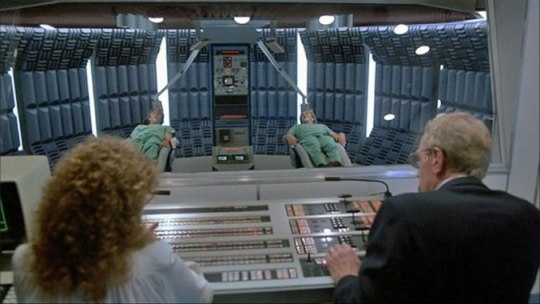
THE DREAM CHAMBER
On an adjacent stage the set for the Dream Chamber was built. Outside, the set looked like a plywood igloo circled with florescent lights. Inside however, a small, padded chamber led to a main control room by a door and a large window. The set was a quiet haven, even when the normal racket of production was going on outside.
“The initial sketches of the set design for the Dream Chamber were some wild approaches that we felt were interesting, but not what we wanted,” Russell said. “Some of them made us feel too much like we were on a spaceship, while others were more like a classic, BRAINSTORM-type, wire-strewn lab. We decided we didn’t want a lot of whirling lights and buzzers, but something quiet and womb-like. It was a very difficult set to design because we were trying to make something that looked authentic, but we didn’t have any precedent for it.”
From an aesthetic standpoint, the design worked wonderfully. From a practical standpoint however, problems cropped up immediately that led to several delays in shooting. The set itself had been designed by Alan Jones without consulting with director of photography Brian Tufano. Jones then abruptly left the production for personal reasons so that when the set was built, Tufano had still not been consulted during the shuffle to find a new set designer. Tufano had great difficulty in setting up his lights and camera within the small confines of the set. An outside computer graphics firm had been brought in to supply authentic looking medical displays for the many small monitors built into the set. Unfortunately, the computer wouldn’t work right and left a full crew standing around collecting pay while technicians tried to figure out what had gone wrong with their expensive battery of equipment. Later, one of the technicians would quietly tell Russell that an Apple home computer would have been sufficient to give them the displays they wanted.
BEHIND THE SCENES / SPECIAL EFFECTS
“Some of the rough figures from effects companies were just staggering in the amount of money, research and development time they would need.” – Chuck Russell
Chuck Russell was told to shop around for people who could create the film’s extensive special effects and draw up a budget.
“It was very exciting to shop the script around and find out what could and couldn’t be done,” said Russell. “Some of the rough figures I got from effects companies were staggering in the amount of money, research and development time they would need. We just didn’t have the preparation time or budget of something like ALTERED STATES.
“When we found Peter Kuran’s VCE and Craig Reardon, and they got excited about the project, we knew they were perfect for it. They even helped sell the project because of their reputations, Reardon’s for working on Steven Spielberg’s POLTERGEIST and Kuran from his work with George Lucas.”
Russell assigned the live action makeup effects to Reardon, and the miniature and optical work to Kuran’s VCE company. Richard Taylor’s MAGI company was also asked to contribute computer animated imagery for the film’s “Dream Tunnel” effects. For the Dream Tunnel, Russell and Ruben wanted a semi-abstract look different from the other effects work in the picture, a “hazy.” dreamlike look, with an object or two from the upcoming scene to form and float towards the viewer to act as a visual cue for what was about to happen.
The effects sequences were storyboarded by Len Morganti; the budget was finalized on the basis of those storyboards. Because director Joe Ruben had not worked with special effects before, he carefully went through each scene with the storyboard artist.
“I knew that I had to be totally committed to my boards,” said Ruben. “I spent a lot of time thinking through the sequences and how I wanted to shoot them because I knew if I didn’t, the film would go out of control because the special effects people wouldn’t know what they were responsible for and what had to be done with each shot. I was able to get just what I was looking for. Morganti would sketch out something and if I asked him to move it a little lower and more to the right, he’d be able to do it with just a few strokes of his pencil. It was almost like working with a camera.”
This slideshow requires JavaScript.
BUDDY”S NIGHTMARE
To try and save money while providing a sense of heightened realism, Russell and Ruben had wanted to shoot the “Buddy” dream, the little boy’s nightmare, on location.
“We found an old Victorian house and were actually shooting,” said Russell. “We realized that by the time you put in the lightning and thunder, it was going to look like Vincent Price was going to come around the corner. It was too on the nose, too traditional. We asked Jeff Stags, our art director, to do something different. He came up at the last minute with the idea of a forced perspective set, sort of Dr. Caligari style. It was a small set, but much more effective, as well as inexpensive. Buddy’s dream is really my favorite because it has much more impact, even though it’s not as spectacular as the last dream.”
Another problem that cropped up involved Reardon’s Snake man suit. Although an impressive work up close, Ruben felt that at even minor distances, it would seem as just a man in a rubber suit. Ruben and Russell still hoped that flickering low-level lighting would help. but Ruben began to realize that even with the extensive work he had put into planning the storyboard angles, the lighting was not going to be enough to sell the suit to an audience. Reardon firmly disagreed, “Contrary to negative thinking about rubber suits, you’ve got to see them as something delightful, and full of potential for doing something wonderful,” said Reardon. “You have to think of them almost as toys. Right when we were about to shoot the basement struggle scene, I went aside with Ruben and said there are two ways of looking at this; you can think of this as a rubber suit which will look bad, or as something which, with the proper angles and lighting, will convince people that they’re looking at a living, breathing, snarling Snake man. Now when Ruben first saw it, he said ‘Oh boy, Reardon, I don’t know…it’s a rubber suit. I thought that had a dangerous ring to it if he really believed it, which was hard to tell because he, Russell, and Loughery had this camaraderie among the three of them based on this constant derogatory kidding. That’s well and good and worth a few chuckles, but where it begins to become pernicious is when it begins to condition thinking to be truly negative.”
Reardon also objected to the low-level lighting strategy that Ruben and cinematographer Brian Tufano used to film the suit. “Tufano seemed to have a fine contempt for any kind of supplementary light which would be, in logical terms arbitrary, but in dramatic terms exciting and interesting … something that would catch the eye, something that would fill in a face or create a little cross light to show textures,” said Reardon. “The naturalistic photography Tufano used can be very detrimental, I think, to SF and fantasy stories. You contrast this with the work of John Hora, who shot THE HOWLING and GREMLINS, and you see that special effects profit enormously from using special tiny spots and direct lighting. But I didn’t feel it was my place to raise the issue.”
Reardon did try to get his viewpoint across to the filmmakers by preparing a lighting test on video. The test was crude but illustrated the alternative Reardon was suggesting. “They ignored it,” said Reardon of the test. “Yet, when they got on the set, they were completely vapor locked on the suit. They didn’t know what to do with it, and they didn’t have any ideas. All the storyboards that had been prepared in advance were completely ignored. Not once did I see anybody bring up a storyboard and crack it open and say that for this frame here we need to set up this angle. All the audacious plans evaporated. Ruben was at a loss to shoot special effects or rubber suits.”
Aupperle s first job was to coordinate the sculpture of the stop-motion Snake man, which was being done by Steve Czerkas, with the suit being built by Craig Reardon.
“They told me that they wanted to feature Craig’s suit prominently, so I was going to try and make the miniature as close as possible to Craig’s suit,” said Aupperle. “We started with a man’s armature and sculpted Craig’s design over it. I knew we were going to have to make some changes, like making the tail longer so it could whip around, but I wanted to avoid one of those instances where the suit never matches the miniature. I’d run back and forth to Craig and measure his design with calipers just to make sure we were dead on.
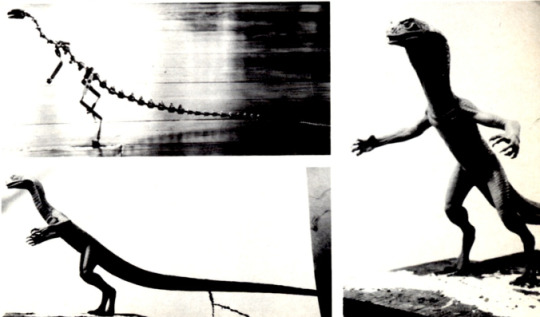
“Since Craig’s suit was being done in pieces our model was the first time the producers saw the way the design was going to come together. They wanted more changes than I ever expected. They actually had Steve Czerkas re-sculpt the model. It got away from the manlike design and no longer really matched the suit. I was a little concerned that the two would intercut, but that’s what they insisted upon.”
Causing Aupperle the most concern was the production’s seeming lack of respect for the story boards. *They wanted to be able to use Craig’s suit any way they wanted,” said Aupperle. “They didn’t want to be tied down by storyboards. At one time they asked me to revise the storyboards. They said they’d just have to wing it on the set. That attitude left me little to do until they were done with the live action. I found the situation very distressing.”
Perhaps the greatest disappointment for Reardon was the scant use made of a full snake-man costume. The suit appears in the film for just a few frames, as the man-snake breaks through a door; most of the action originally planned for Cedar was replaced by Jim Aupperle’s animation using models built, following Reardon’s design, by Steve Czerkas.

THE SNAKE MAN
Most changes made in the script did not alter Loughery’s story significantly. In Loughery’s original draft, the creature that menaces Buddy in the boy’s dream and later reappears as the creature stalking the President and Alex was to be a rat-man. “We changed that because so much had been done with werewolves,” said Russell. “This was right after THE HOWLING and AMERICAN WEREWOLF IN LONDON and we felt the difference between a man with a rat’s face and a man with a wolf’s face would be minimal.
“We wanted to take a different approach,” Russell continued. “Not the direction of John Carpenter’s Thing but something identifiable, so that when Tommy Ray changed into something to scare Alex, you would be able to see that it was Tommy Ray’s version of the same creature. Joe Ruben wanted to go with something that scared him, and since he’s scared of snakes, we went in that direction. I did some sketches of a snake creature and came up with something that really excited us because it was a departure from anything either of us had seen before. I think part of it came to me from my memories of seeing THE SEVEN FACES OF DR. LAO. When we showed it later to our effects people, Peter Kuran and Craig Reardon, they were really sparked by it too.
A stop-motion animator was the last member of the effects team to be hired, done through VCE. Both Russell and Ruben had agreed early on that the best and cheapest way to get what they wanted from the Snake man sequences would be with a mixture of live-action and stop-motion effects, but they were unsure just how they would mix the combination.
“I knew we would need a good animator,” said Russell. “I knew a live-action Snake man with its long neck and swishing tail would never work in a master shot. We didn’t have umpteen million dollars for physical effects.” Russell and Ruben planned to use low-key, flickering lighting for the sequences in order to seamlessly blend the two effects techniques.
Said Russell, “ Joe and I sat down with the special effects people on the Buddy sequence storyboards, which is the first appearance of the Snake man, and asked which way it made more sense to do it? It made sense to do the wide shots in stop motion and the close-ups in live action, and in the cases where we weren’t sure, we would have both of them overlap and whichever worked better, then that’s what we would go with.”
Although this arrangement was made in good faith and with the best intentions, the decision to let the two techniques overlap and not make a clear distinction between which shots would be assigned to each ultimately proved to be a decision that led to tensions and feelings of betrayal between makeup expert Craig Reardon and the production company.
Opticals were also used to create the clouds and background sky for the first dream that Quaid enters, the vertigo dream where he goes into the mind of a steelworker and falls. “There’s one shot where Dennis Quaid is supposed to be falling. said Kuran. “I spent some time trying to figure out how a person should fall so it will look right on film. We had a good plate of a falling background, and they rigged an elaborate harness at Raleigh to hold Dennis. When we were on the set. Ruben asked me how a person should fall, and I went through the motions of what Dennis should do, but Joe didn’t do that. He told Dennis to do something else that looks really corny. He ruined the shot. There was no way that I could think of to fix it and I think it looks really cheesy right now.
THE PRESIDENTS NIGHTMARES
At a budget of over $300,000 for some 90-odd cuts, DREAMSCAPE was one of the largest jobs VCE had taken on, as well as one of the most difficult. As the producers were continually asking VCE to create more or make changes with what they had done, Kuran wasn’t under pressure to have all the special effects done by the original deadline. Kuran pretty much improvises his effects as he goes along. The more they wanted him to do, the less certain he was about how much longer it would actually take to finish the effects. One thing was certain. There was no way they’d be able to get the movie out in the fall as Russell had originally hoped.
In a way though, the delays had been a good thing; something everyone was almost afraid to acknowledge because of all the tribulations the film had gone through. Kuran was creating the effects layer by layer, and even with only early tests to show, the effects still looked very good. It helped convince Curtis that even though the schedule and budget had gone to hell, it was still within limits he could work with—he was getting a better product for his money than he ever dreamed possible. The more Kuran tinkered with the visuals, the better they got. The live action footage of the actors had come out better than expected, too. Quaid and Von Sydow were marvelous in their roles, and if they could just get the effects to come out anywhere near what had been described in the script, they all began to feel they might have a movie yet, even if they did have to grimace a bit when they realized that the work on the film was still far from over.
Working with Zupnik-Curtis productions was not without its problems for Kuran in the beginning. Because Curtis had never worked with special effects before, he wasn’t sure what to expect.
“We started getting pressure from them early on,” said Kuran. “They had a rough cut of some of the sequences for us to work from, and they wanted to see something. But they kept changing the cutting without realizing that it meant we’d have to go back and redo the whole scene. There was a trolley shot that they wanted to make longer by one foot of film. At that point, all the backgrounds had been shot to length. All the miniatures had been broken down. I managed to talk them out of that one.”
Another problem is the very nature of post-production work. “When somebody does a movie, they make a little mistake here and a little mistake there, and if it doesn’t work, they just kind of throw the shit over their shoulders and it lands on them in post-production,” said Kuran. “Unfortunately, this is where we do most of our work. People are at their worst to deal with in post-production. They’re under deadlines, and if the movie doesn’t work they’re in even worse shit. The people who shot the movie are gone and they usually refuse to accept the fact that the movie is crummy because of them. Lots of people can go onto a production and create a lot of shit and come off smelling like a rose because the movie’s not finished when they leave it.”
Although VCE was contributing some 90 cuts to the film, the majority of the effects were going to be clustered around the holocaust dream near the end, and at the start, including the terrific A-Bomb teaser which opens the film. “I thought the bombs in THE DAY AFTER just didn’t look right,” said Kuran. “They looked so dark and cold. You look at a nuclear test and you can see it’s a very bright fireball, so we wanted a very hot look to our bomb.”
The Trolly/Subway Cart
Reardon’s and Kuran’s most elaborate work is seen in the climactic sequence, a surreal view of the day after Nuclear Armageddon. Dennis Quaid enters a dream which represents the President’s worst fears of nuclear war, the setting is an old trolley car that travels among the bombed-out ruins of Washington, D.C., past several surrealistic tableaux-travelling mattes and miniatures courtesy of Peter Kuran’s V.C.E. David Kelley, Plummer’s henchman, enters the dream as well, for a climactic confrontation with Quaid.
For the holocaust dream at the end, Kuran’s basic effects strategy was to have a live-action foreground element, an intermediate miniature behind that, and then have a matte or tinted water tank shot as the background. The scenes were difficult because Kuran needed something that would convey a sense of extremely large scale while still having realistic detail, a tall order on the show’s tight budget.
Russell had originally wanted to do the holocaust effects scenes first and rear-project them as they were shooting the live action. Kuran pointed out that it would take thousands and thousands of feet of film to try and generate the footage they would need, and that they would have a better chance of making sure the background footage matched with the live-action trolley car if they shot the trolley first and then had it to play the backgrounds against.
“Jim Belohovek and Sue Turner built the miniatures for the scenes, and we photographed them in different layers,” said Kuran. “To get good depth of field, we shot them at one frame per second. Then we started adding the fires. Because those had to be slowed down, we shot them at 72 frames a second. We don’t have any motion control equipment. I set up a dolly for the camera, filled the room with smoke, then lit the fires. It takes a couple of seconds to get the camera up to speed. Then we pushed the dolly down the tracks until eventually timed the push right and got it to look the same speed that we thought the trolley would be moving at. The background is a water tank shot that we used to make it look moody by adding some glows and fires. Counting everything I’d say there’s about 20 elements in that shot.”
While Kuran labored in the bowels of VCE, director Ruben and Academy Award winning editor Richard Halsey were slowly cutting the film together using unfinished optical tests that were the right length and Jim Aupperle’s Snake man animation. Kuran had been able to find them an east coast underground filmmaker named Dennis Pies (pronounced “pees”) to do the Dream Tunnel effects and the stuff looked wonderful. It was exactly what they wanted. But now it was time to decide how they were going to mix the live action Snake man and the animation, and to a great degree, they were coming down against the live action footage.
With the will to manipulate the dream to his own ends, Kelly at one point extends his fingernails into stilletos, which he uses to rip the heart from the car’s conductor, with the logic of dreams, the trolley then becomes a subway car, populated with a dozen grisly war victims, looking more dead than alive, Shortly after, Kelley transforms into a snake monster.
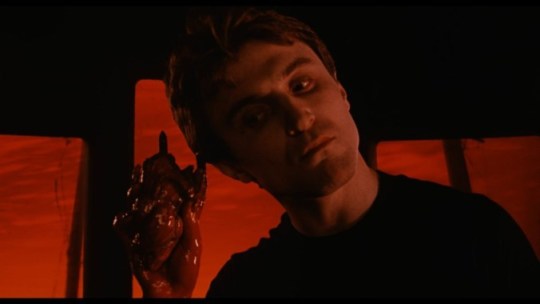
Reardon details the other effects he did for Dreamscape. “Tommy Ray Kelly transforms with knives springing from his fingers. He uses these to tear out someone’s heart which sits beating in his fingers,” the effects Technician says. “We made a prosthetic hand and an artificial heart for this scene.
This slideshow requires JavaScript.
“We made 12 mutants up for them, Reardon says of the subway denizens, “all extremely exaggerated in their ugliness, so that, in the heavy shadows and flickering light that was planned for the shot, they would still prove effective. The design is heavy-handed, but suitably macabre for the scene.
“I hogged all the major sculpture on the picture for myself, but there were a number of other people working with me on this that also deserve mention. My greatest praise must go to Bruce Kasson, who took the weight off my shoulders where mechanical work is concerned. He worked out the mechanical effect used for the death of one of the characters at the end, as well as the stilleto fingernails. David Miller was our acrylic man, doing all the hard plastic pieces, and certainly one of my right hand men in doing the sculpture, along with David Cellitti.
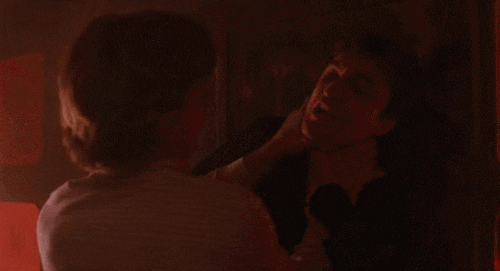
Snake Man Transformation Effect
Following the completion of principal photography, there was a brief hiatus, during which Reardon re-stirred his somewhat-dampened enthusiasm, before tackling the transformation sequence.
Replacement animation is a variety of stop motion that uses separate, slightly differing sculptures, rather than the movable models most frequently associated with the form. Pioneered by George Pal, replacement animation is nowadays seen mostly in David Allen’s television commercials featuring such animated characters as Mrs. Butterworth and the Pillsbury Doughboy. Reardon’s suggestion to try this technique for an unusual transformation. Because of the frame-by-frame nature of the animation process, the sequence would be a short one-less than two seconds in sculpting work than Reardon (or, most likely, anyone else) had ever expended on a transformation effect of such short duration; 32 heads, each altered slightly from the previous head in sequence, each making a barely more than subliminal appearance in the film. It was this rapidity, and the violence of the change, that Reardon felt would make it entirely unique.

“The major problem was one of time,” Reardon says. “How was I to produce 32 different heads for this sequence within a reasonable schedule? The first thing you want to consider in a situation like this is, can you do it full-size? It took me about 15 seconds of heavy thought to realize that would be a killer, because of the molds that would be involved, and the sheer awkwardness of doing such an extensive sequence in full scale. From the beginning, they wanted David Kelley’s features discernible in the snake head’s face, so l also briefly considered taking a cast of Kelley’s face and using reduction techniques, like special shrinking molds, to bring it down to scale-but there is enough distortion in the reduction process that it wouldn’t likely be worth the effort. So I finally decided on doing a miniature portrait sculpture based on his features.
“One way to have gone would have been to produce molds of each and every stage cast one head, alter it a little further, make a mold from that and cast another stage. I ruled that out; it takes about a day to make one mold, so it would have taken a full month to prepare for the sequence.
“Instead, I took a master mold of the first stage turned out a dozen or so duplicates of that, and altered each of them to cover the first third of the total transformation. I then made another mold from the last of these, and changed those progressively. That way, I had to make no more than three molds. As the work progressed, I did some rough tests on video, which helped to show up a number of small glitches. Some of these proved very difficult to correct-seen side by side, two heads might appear to match perfectly, but tiny variances would show immediately on video.”
This slideshow requires JavaScript.
A chief problem with all stop motion effects is that of temporal aliasing,” a term used to describe the unnatural look of objects seen to be in motion, but not blurred as they would be if actually filmed in real-time. All along, Chuck kept saying, ‘I hope this won’t look like animation,” says Reardon, “and of course all I could say was, I hope so, too.’
“Jim Aupperle, who did the stop motion animation on the snake monster, and my friend Randy Cook, made some suggestions to counter that problem. Both suggested that if each stage would be slightly dissolved into the next stage, that would soften the edges, and disguise whatever anomalies there were from one head to the next. So Peter took the negative and a dupe negative, printing them to a single positive with overlapping frames, so that no single frame gives a really razor sharp image of one sculpture.
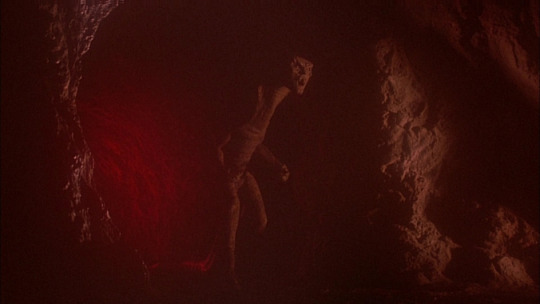
The Caves
Another kind of problem arose in shooting the climax of the President’s holocaust dream, set in a cave-like underground grotto decorated with fires, twisted girders and a glowing pool of green water. Originally it was planned to shoot the scene on a section of the ruins” set at Raleigh Studios. But Russell found out that he could get a few days shooting time at Bronson Canyon. The site, long a favorite locale for low-budget productions, is actually a short “Y” shaped tunnel through a jutting canyon wall in the nearby Hollywood hills. Open at all three ends and with a high ceiling, Ruben and Russell felt they could put up a more effective set inside the cave at relatively little cost to the production.
The art department scrambled on something like 48 hours notice to come up with a revised set for the cave. They did well, but lighting the set so that the lights themselves wouldn’t show was a difficult task made harder by the fact that creating the pool of water just past the junction of the “Y” in the cave had turned the rest of its sandy floor into gritty muck that forced the crew to support the lights and camera on wooden planks and sandbags the best they could. Working in the enclosed confines quickly turned miserable too. Brian Tufano, who had been hired because of his work on QUADROPHENIA and THE LORDS OF DISCIPLINE, is yet another British cinematographer who likes to use smoke to diffuse his lighting to give the set greater visual depth. Every time Ruben went for a take, Tufano’s assistants would pump the small, sealed cave full of hot, oily smoke and wait to see if the density was right. While the crew and stars quietly gasped behind their respirators, either more smoke would be pumped in if it wasn’t enough.
According to Craig Reardon, the first scenes that were supposed to be shot in the caves were thought to be relatively straightforward. Quaid, followed by Albert, is moving through the cave when they are attacked by a mutant dog. For the dog’s costume, Reardon’s assistant, Michiko Tagawa, had made some wonderfully revolting costumes.
“They were beautiful.” Reardon said. “They had entrails bulging out of the body and exposed rib cages and boils and french fried skin. Now we were told that a Doberman would wear the costume, and in fact, the trainer had auditioned the dogs in a costume they worked in on the BUCK ROGERS television show. So Michiko went to a great deal of trouble to measure the Dobermans and I contributed sculptures for the heads while she built the body parts up from reject castings for the subway zombies.” Once we got them suited up at the Bronson location however, the Dobermans refused to perform.
“The dogs trouped around in the mud and the zippers and their fur got packed with it,” said Reardon. “It was a disaster. They took one of the suits and tried to put it on a German Shepherd, a dog which is considerably different in body build.”
In his big scene the dog was supposed to run a short distance and jump at Quaid. In take after take however, the dog merely trotted up to Quaid and stopped at his feet to try and shake the costume off. Eyes turned on the dog’s embarrassed handlers who quickly explained that the dog usually didn’t act like that; it was probably because he felt uncomfortable with the costume.
Reardon snipped parts of the costume’s legs away, hoping to make it more comfortable, but this produced no better reaction. Next, the dog’s owners took to furiously waving a little furry target at the dog. then quickly sticking it just inside Quaid’s shirt while everyone enthusiastically urged the dog to attack. This made the dog think everyone just wanted to play. It would run up to Quaid, half-hop once, then bark excitedly while waiting for his trainers to get the toy again.

Quipped Reardon, Bruce Cohn Curtis said the mutant dog looked like someone’s dirty laundry running across the floor.” Finally the dog made one decent leap past Quaid and Ruben called it a take. The shot is still in the film, although the rest of the mutant dogs were replaced with German Shepherd with their fur shaved in patches and dabbled with red goo.
“The script also called for these two raggedy dogs to chase after Quaid and Albert in the dream. It seemed that the easiest way to achieve a really striking appearance for the dogs would be to suit them in a costume covered with foam latex. I consulted with the trainers on the feasibility of it, and they said
‘Yeah, sure.’ So l sculpted two mutated dog heads, and Michiko Tagawa, a very good craftsperson who’s done work with Winston and Burman, did a beautiful job on the body suits-really hideous and nasty. She took some reject castings from the subway mutants, and reworked them into twisted body shapes, warped, burned and decked with growths. But the dogs wouldn’t wear them, and the trainers sort of shrugged, and said ‘What do you expect?’
“Those trainers were let go, and replaced by Karl Miller, who allowed them to shave his dogs in erratic patches, and we gobbed all kinds of blood, goo and crap on them. Good enough, but it’s unfortunate that Michiko’s suits will never be seen.”

VCE generated the bits and pieces that would help add life and highlights to the live action effects. A red glow was added to the mutant dog’s eyes, as well as crawling purple electrical effects when the dogs vanish. Opticals materialized David Patrick Kelly’s nunchaku weapons smoothly into his hands as well as allowed Dennis Quaid to heal his wounds and transform himself into Kelly’s father.

Snake Man Showdown
The next scene planned for the cave involved Quaid and Albert, discovering it is a dead end and that the Snakeman is right behind them. It comes out of a side tunnel, snarls, and attacks Quaid. Ruben decided he wanted to use the full-sized Snakeman suit for the shot, and Reardon was given short notice to get it ready. At the time, Reardon was working full tilt to prepare the suit needed for the basement struggle in the boy’s nightmare. A different head would be needed for the cave sequence.
“Russell got a hold of Bronson Canyon and said we’ve got to do the Kelly head to look like David Patrick Kelly, playing the President’s assassin) right away. You can’t change things around like that. I said I’d try when I should have told him no.”
Ruben shot Reardon’s live Snakeman suit in the cave, although eventually discarded most of it and replaced the scene with a stop-motion cut. Also discarded was a small but important effect Reardon had worked very hard on getting right, a brief shot where Dennis Quaid “heals” a wound in his shoulder.
This slideshow requires JavaScript.
“We created a sort of bite effect, then put a plastic membrane over it and melted it with a plastic solvent so that when they ran the film backwards, the wound would heal,” explained Reardon. “It didn’t work as well as it did on the bench, which is frequently the case, but you did get a feeling of the actual fleshy material knitting itself. They opted to have Peter Kuran redo it with animation.”

More successful was a Reardon designed effect where Kelly, now distracted by an ingenious ploy of Quaid’s, reverts to a half-human, half-snake form. While diverted, Albert sneaks up behind him and drives a length of pipe through Kelly’s chest. For this shot, Reardon made a false chest with a mechanical rubber pole section inside that was connected to a spring and operated by cable. Albert would sneak up holding the pipe, then drop it out of camera sight as he lunged for Kelly, and the rubber pipe would burst through a section of painted tissue paper. Although the complex mechanical effect took some time to rig, it was accomplished in only three takes and is gruesomely realistic. It made for a happy interlude before the crew was to run into yet more problems once they left Bronson Canyon and returned to Raleigh Studios.
Dave Millers Unused Snake Man
“I also worked on a snake man head, the one that was originally going to be in the elevator sequence, emerging from the head of Dennis Quaid. But then, they had some kind of quibble over Craig’s head of Quaid–they said it didn’t look like him, or some such garbage-and they hired Greg Cannom to do that sequence over. Greg did another head of Quaid, which they wound up not even showing, though it looked perfect, and another snakeman, which-sorry, Greg I didn’t care for too much. It didn’t seem to have much definition; it was hard to tell what it was. Plus, it was pretty badly edited.” – David Miller
BOB BLAIR’S DREAM DEMISE
The “Buddy” dream completed the bulk of the main shooting. DREAMSCAPE moved from the largest soundstage at Raleigh into one small stage for what was hoped would be the final shot of the would grasp what was happening. Because Quaid’s strike against Plummer was to be a surprise, Ruben and Russell felt it was absolutely necessary to make sure that the lighting look realistic right up to the moment of the attack. This meant shooting the effect not with lighting that would highlight the makeup, but with ordinary florescent lighting. Reardon hated the lighting, but went along with Ruben’s insistence that changing the lighting would tip-off people that something was about to happen.
This slideshow requires JavaScript.
About a month earlier, in late June, Reardon had supplied a transformation head, known as a “change-0” head in the business, for a scene late in the film in which Dennis Quaid confronts political schemer Christopher Plummer in the one place where Plummer is vulnerable, inside Plummer’s own dream. Quaid borrows a trick from dream assassin David Patrick Kelly and changes into his own version of the Snakeman before killing Plummer. The effect was planned to first show Quaid’s head beginning to change, cut back to Plummer as the Snakeman’s hands shoot out for his throat (a very brief scene which was shot earlier) then a quick cut back to Dennis Quaid’s Snakeman head coming for the camera.
“We prepared a head, which I felt was better than a lot of THE HOWLING heads,” said Reardon. “We didn’t content ourselves with just having the face bulge out. We had the eyes blink, and when they opened they were snake eyes. At the same time the neck elongated and the cheeks distended, and the eyes began to pop out of their sockets. The mouth opens unnaturally wide and the teeth elongate. But nobody liked it. Ruben said to me, ‘Geez Reardon, I expected something like AMERICAN WEREWOLF IN LONDON.’ That’s great. You give me six months and six hundred thousand dollars and maybe you could get that. Besides, that effect was five different heads. I told them all along that I was only going to come up with one head and do as much with it as I could.”
Neither Russell nor Ruben had been happy with the head when Reardon had brought it in. Under the flat lighting of the elevator mockup, the hair looked too bushy and still, the face too lifeless, and the neck far thicker than Quaid’s. The head didn’t work well either. with eyes that frequently jammed as they started to roll up. It took several takes to get the mechanism to work right. But beyond that, when Ruben and Russell saw footage of the effect, they realized that what they thought would be a good visual just wasn’t that exciting.
“Forget that it wasn’t convincing on film,” Ruben said. “When I saw it, I just realized that we needed a more shocking effect.”
“It wasn’t exciting enough,” added Russell. “We didn’t realize that until we saw it. It was a subtle effect that just wasn’t explosive enough. Craig’s head didn’t show anything either that would connect it with the Snakeman, and we decided we needed that, so we racked our brains and decided on something simple, like a guy’s head ripping apart with the Snakeman’s head coming out of the pieces.”
Russell contacted Reardon, but by this time, Reardon was both fed up with the production and busy trying to finish the replacement animation for David Patrick Kelly’s Snakeman transformation so he could be done with the film. Since Reardon was busy, Russell had to find someone who could do the effect and do it quickly. He decided on Greg Cannom, a former assistant to Rick Baker and Rob Bottin. Cannom’s first solo assignment was THE SWORD AND THE SORCERER, and more recently he assisted Baker with the apes for GREYSTOKE.
Cannom had talked with Russell about a year before DREAMSCAPE about another film project that never went through. Cannom was interested in the assignment, but checked with Craig Reardon first, before committing himself. Reardon gave his blessing. Cannom went into his workshop and tried an effect which would combine the two concepts that Russell discussed, creating a skull that would not only split apart, but split apart and turn into a monster at the same time. “I could see the use of the Snakeman with the kid’s nightmare, but going into an adult’s nightmare, I thought it should be a lot more horrendous and scary,” said Cannom.
Cannom’s first prototype makeup was deemed unacceptable by producer Bruce Cohn Curtis. It was a bitter decision because of the amount of effort Cannom had put into it. Cannom took a fiberglass skull which he cut and hinged so it could be pulled apart. Inside the skull, Cannom used a soft foam and sculpted a hideous face so that when the skull was pulled apart, the jaw would drop down and the foam face would come out to form the monster.
“I loved Cannom’s first approach,” said associate producer Chuck Russell. “I think it was terrific. The dangerous thing about the makeup was that in a very quick cut, with a man splitting his head open and something gooey, dark, and spongy coming out, it might look like brains. It was hard to argue for it because of that.”
Curtis told Cannom that they wanted something closer to Reardon’s Snakeman concept. Cannom tried to figure out how to fit Reardon’s Snakeman design into a reworked version of the splitting skull but finally gave up and settled for a two-piece approach. Cannom first built a small, embryonic Snakeman head which would be moved like a hand puppet inside the skull after it split apart. Cannom wanted to stop the camera and replace the small head with a fullsized but slimmer Snakeman head that would rise out of the neck and lunge for the camera dripping goo and skin. As with Reardon before him, Cannom was less than happy with the treatment he felt his makeup got from Ruben and Curtis. Assisted by Jill Rocklow, Kevin Yagher and Brian Wade, Cannom did the effect, but felt little enthusiasm for the final product.
“Bruce Cohn Curtis and the other producer, Jerry Tokofsky, were so insulting and rude to me it was incredible,” said Cannom. “It was like they already had something against me and wanted to find fault. I never want to see Bruce Cohn Curtis again.
“I don’t really think my effect works either,” added Cannom. “It’s not done the way we wanted to set it up. We were very careful about it. First, the skull would split apart, then we would cut away, put the snake creature back into the neck and put skin all around it, and then have it come at the camera. I spent hours getting the chicken skins for the makeup and preparing them, then setting-up the effect. Ruben looked at it and said, ‘That’s not what I want. No neck and no skin. I just want the head coming at the camera.’ I told him that didn’t make any sense! But that’s what he wanted, so we did it his way.”
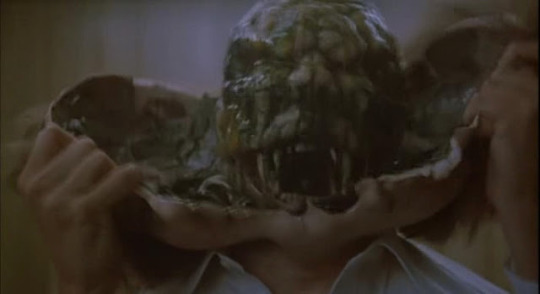
POST PRODUCTION
Because Ruben and Halsey had been able to do much of the editing work while the final opticals were being generated, the final scoring and assembly of the footage was completed quickly. Curtis had a finished film only a month later and premiered it to his friends in mid-January at a small mixing theater in Hollywood. Although there were some clunky spots that hadn’t been fixed because of time and budgetary problems, the final cut was deftly edited around most of them and they were visible only if you knew what to look for. The audience gave the film a big hand and Curtis was very happy, as well as Kuran. Russell, Ruben and Loughery, who now looked forward to having a potential hit associated with their names. Although Craig Reardon liked the film, he was still unhappy with director Ruben.
Ruben defended his decision to replace Reardon’s work. “Craig was under tremendous pressure to deliver an awful lot of complicated physical effects,” said Ruben. “I wouldn’t be able to see a finished physical effect practically until the day we were ready to shoot it. That was a rough way for both of us to work. I was disappointed some times, and I’m sure he was disappointed in the way I was shooting things, although at no time can I remember him making specific suggestions. I think that the main thing I would change if I were to do it again, and I wouldn’t mind working with Craig again.
youtube
Dreamscape (1984) Music by Maurice Jarre 01.DREAMSCAPE 2:58 02.THE JOURNEY 4:22 03.FIRST EXPERIMENT 1:55 04.SUSPENSE 2:09 05.JEALOUSY MERRY-GO ROUND 2:56 06.THE SNAKEMAN 1:08 07.ENTERING THE NIGHTMARE 4:17 08.LOVE DREAMS 4:10
REFERENCES and SOURCES
Twilight Zone v04 n01_ Fangoria 44 Fangoria 27 Fangoria 34 Fangoria 39 Cinefantastique v15 n02
Dreamscape (1984) Retrospective SUMMARY Alex Gardner (Dennis Quaid) is a psychic who has been using his talents solely for personal gain, which mainly consists of gambling and womanizing.
3 notes
·
View notes
Text
On March 27, four Widener English majors–all Blue Route staff members–and two faculty members traveled to Portland, Oregon to attend the annual Association of Writers and Writing Programs conference. Along with nearly 12,000 other writers, readers, editors, and publishers, the team enjoyed three amazing days of panels, networking opportunities, enlightening readings and keynotes speeches, and of course, the pacific northwest! Read on for a few words from all four senior English majors about their time in Portland!
Kelly Bachich Carlie and I signed up for an hour of manning the FUSE table in the book fair section of the conference. While we were setting up, Carlie nudged me and said, “Kelly, doesn’t that dog on that poster over there look just like the one you wrote about in Historical Fiction class?” Low and behold, I look over and the juxtaposing booth is sporting a poster of Laika, the space dog from the Sputnik II mission that I had just written about the week before coming to AWP. Naturally, I had to go over and investigate. I asked the woman working the booth why Laika was on the poster and she informed me that their book press had published an author who just wrote a biography on Laika. Not only were they selling copies, but he would be there signing them in an hour!
I purchased the book and stood waiting in line, mustering up the courage to ask the author, Kurt Caswell, if I could send him my short piece to read. I am a pretty confident and outgoing person but, for some reason, the minute I was next in line I almost chickened out. I told him about the poster and why I had to buy his book and meet him to tell him that I had also just written about Laika. He handed my book back to me after a really great conversation about Laika and I knew my window to ask him to read my story had closed. Then, to my complete shock, he asked me to send him my story to read and even gave me his personal email to send it to. I was elated.
Later that night, Rohan met a panelist named Shayla Lawson who wrote a poetry chapbook mixed with Frank Ocean songs and got us invited to a “battle of the bands” where she performed her work with her band. One of the opening acts, however, incorporated the song “Space Oddity” by David Bowie into his piece. The minute I heard the lyrics my head snapped over to look at Carlie who was already staring at me, mouth agape. “Space Oddity” is also an integral part of my short story about Laika. In a three-page story there is not much room and for two major aspects to crop up so blatantly at AWP had to be a sign for me to continue working with that piece. AWP is an invaluable resource for English and creative writing majors, it is a hub for creative minds and a space where we can feel important and bond with other professionals.
Vita Lypyak The first panel I attended at AWP was one of my favorites. It was titled “Translators Are the Unacknowledged Ambassadors of the World,” which is a play on the famous Percy Bysshe Shelley quote, “women are the unacknowledged poets of the world.” I speak two languages besides English, so languages and translation is something that always interested me. The final panelist opened my eyes to the Iranian culture and the struggles associated with translating Iranian literature to English. Unlike the first two panelists, she explained that Iran, as a nation, hinders its own artist by utilizing strict censorship and even executing writers. As a whole, this panel made me understand the crucial role translators have in the dissemination of literature. It helped me understand that translating is also a form of creative writing; a translator has to not only present the same meaning of the original work, but also closely match the same style.
In a sense, translators are poets and makers of things, too; they give readers access to things they could have never reached, due to a language barrier. AWP features a lot of intellectually stimulating and educational panels, which are great, but they can also cause a lot of mental fatigue. By attending poetry readings and readings of other kinds, it really helps your mind slow down and recharge, at least that was my experience. At “A Wild Girls Poetry Reading,” I was particularly moved by one poet, who wrote a collection of poetry where she was attempting to deal with the grief associated with her younger brother’s suicide. The stories she told the audience and the poetry she read were so raw and they made me empathize with her so much. I attended this reading on the first day and I could not stop thinking about her work. Her words impacted me the entire trip to the point that on the last day, I went and bought her book. I had to or I would never forgive myself. After I purchased it, I sat outside and read it from cover to cover, and her words continued to move me.
Rohan Suriyage I decided to go to Page Meets Stage, a reading that is a yearly tradition at AWP. This was the best decision I made throughout the time of the conference. The reading consisted of five poets reading and performing poems after one another, “popcorning” in order and choosing what to perform based on what was read before them. The panel was led by Taylor Mali, four-time poetry slam champion and arguably the most famous American spoken word poet, and consisted of other notable poets like Anis Mojgani, Mark Doty, and Shayla Lawson. For the whole hour I just sat there, mouth agape, at the incomparable stage presence and refined performing art they all shared with the room. When it was time for Shayla Lawson to read, she prefaced her poems in explaining they were all from a book of poems inspired by Frank Ocean, an R&B artist and one of my main artistic inspirations. When Shayla finished performing “Strawberry Swing” from her poetry book I Think I’m Ready to See Frank Ocean I struggled to retrieve my jaw from the floor and knew I had to speak to her after. Upon the panel’s conclusion I was able to do so.
We talked about Frank and our common interests, and after we spoke, she invited me to come to a reading she was orchestrating in downtown Portland. Of course, I obliged and I ended up going after the last of the panels of the day. In the library room of the Heathman Hotel, I heard Shayla and 4 of her colleagues read marvelous poetry. All of them are part of an association of writers called the Affrilacians, about 2,000 southern writers strong (per Facebook). Two of them I met and spoke with, published poet and educator Mitchell L.H. Douglas and former Kentucky poet laureate and educator Frank X Walker. Both were incredibly down to earth men who gave me insight on getting published and furthering my education, and I thank them for that. To whoever made the decision to take me as one of the students to go on AWP this year: thank you. Thank you. What I owe you can never be repaid. This was a span of days I can’t see myself ever forgetting, a span of days I firmly believe will prove to be important as I further my writing career.
Carlie Sisco One of the panels I attended was titled “8 Techniques Guaranteed to Take Your Script to the Next Level.” Using examples of films such as “Juno,” “Star Wars: A New Hope,” “Pulp Fiction,” and “Little Miss Sunshine” among others, this panel offered techniques relative to character, scene structure, descriptions, and dialogue. Though I do not write screenplays myself, I have always loved reading the screenplays to my favorite movies and television shows. It makes a very visual experience feel like reading a book. This panel demonstrated the ways in which some screenwriting techniques have the ability to transcend into fiction writing, because, even if I am not worrying about camera angles, it is still storytelling. Screenwriting can sound like a novel just as a novel can read like a screenplay.
Something that stood out to me in particular had to do with a tip on character development: “we watch movies because we want to connect with our characters.” Is that not the same for fiction writers? Shouldn’t I also be focusing on want versus desire, asking emotional questions in scenes, considering symbolism and foreshadowing, making my language visual or finding imaginative ways to introduce my characters? Isn’t it good advice regardless of the medium to think about increasing tension and suspense by slowing down, using misdirection to reveal information, or revealing my characters through their actions? I chose to go to a variety panels on screenwriting and playwriting not because I want to try my hand at either one, but because I know that the techniques between them and fiction writing are interchangeable. I also know that films and television serve as my influence, the driving force that compels me to provide visual detail and intricate characters. I would not have been able to explore what that means to my writing or how related the two mediums are had I not been given this opportunity. My path may not have been the one most fiction writers would typically take, but I think that is what was so amazing about AWP at the end of the day. I was able to find what interested me and gained insight from an influencing medium all while taking my own unique path.
This slideshow requires JavaScript.
by Carlie Sisco
Recently our senior staff members attended the 2019 AWP Conference in Portland. Click the link to read about their experience! #AWP2019 On March 27, four Widener English majors–all Blue Route staff members–and two faculty members traveled to Portland, Oregon to attend the annual…
1 note
·
View note
Text
[Second week of 2018.09] Busan Indie Connect Festival!
Sorry I was late, I had to postpone the posting one day because the schedule was so busy. So, thank you for waiting my devlog!
Hi, there!
I will try to make an important announcement before the start of devlog. Starting this week, I started to do level design, plot, and visual work.
So, coincidentally, it became impossible to avoid making it difficult to write a devlog every Sunday, so I decided to write a diary every two weeks, and decided to post a status report on another week.
However, this week is the second week, so I will fill in the details. (First, third week = status) (Second, fourth week = devlog)

And the theme of this devlog is the indie game event held in Busan. In other words, I participated as an exhibitor at the Busan Indie Connect Festival.
It was a good place to meet many developers. Thanks to Waffle, the developer of ‘The Starry Night’ who was able to provide such a precious place. Let's begin.
Plot writing... and improving dialogue window...
Now, as I mentioned above, I'm working on the details of the plot in the current big-frame game, and I'm working on improving the script as well as moving the dialog window interface from the canvas to the world space.
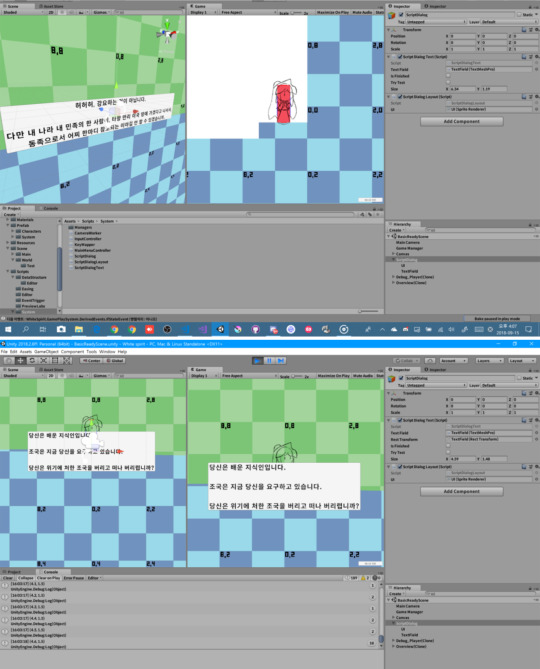
This is the situation I had working on.
Depart for Busan!
First, let me introduce the background story that I was able to participate as an exhibitor of The Starry Night.
...
Waffle, who previously worked on The Starry Night, is a close ally with me. I knew that he was not a major in programming. He was developing mobile games using RPG MAKER MV.
One day, after I finished developing, I bored and told Waffle. I was talking how about planning localizing in another language. Then Waffle said, I will copy the whole project and build a version that has changed the language. I have heard some very shocking plans for me.
So, from that moment on, I've become a developer of text localization plugins using JSON, and I've become a developer who has helped to develop a pretty important part of the game.
Because MV is an engine that uses JavaScript, I implemented it right away. It's very easy to use compared to other localization plug-ins. I thought it was good.
Then one day in August I received a phone call. It was a phone call from Waffle, and I was offered a suggestion from Waffle to go to BIC and meet with the developers there.
I think now that the game being developed is very early in the game, and if it is not now, it's hard to make a chance. I was ready to talk with you right away.
So on the 12th of September...
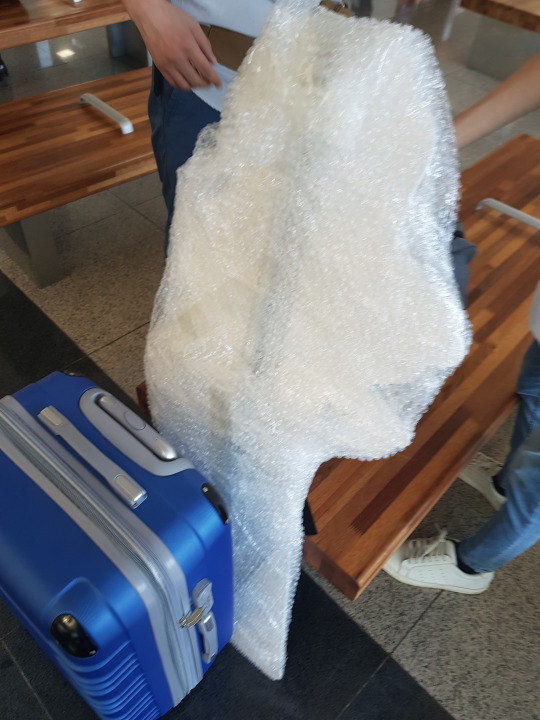
We took the exhibition model of Tia, the protagonist of The Starry Night(...)

Then we arrived at the hostel's hostel. Two people were free, and the next person had to pay $ 20 per night for a discounted price. I think it is well worth going out because it is something I can not easily experience where I go.
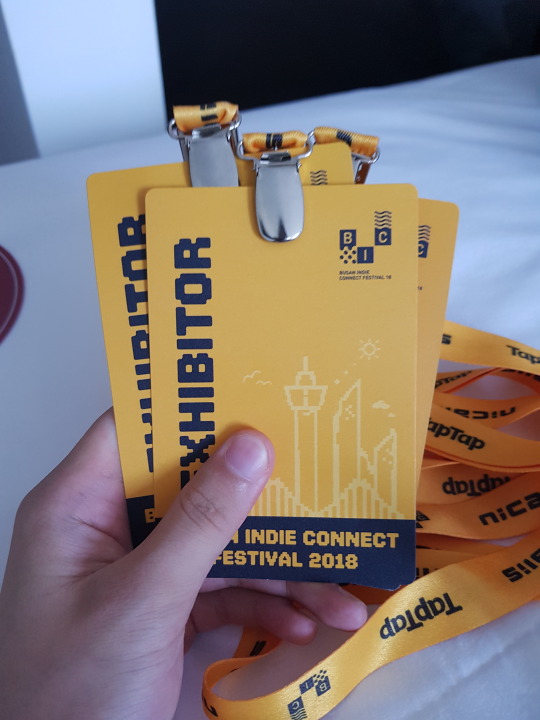
Receiving the exhibitor ID card...
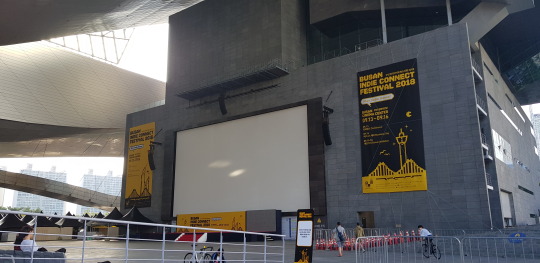
It was before the start, but we went ahead and watched. It's one of the biggest gaming events in the Hall of Fame.
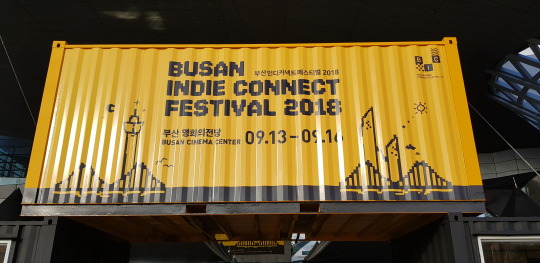
The entrance has a BIC title on the container. I feel something different.
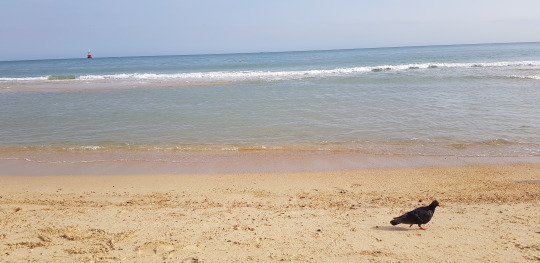
At the end of the day, we moved to Haeundae, and we watched the beach. The beach where the pigeons go, rather than the seagulls, feels different lol
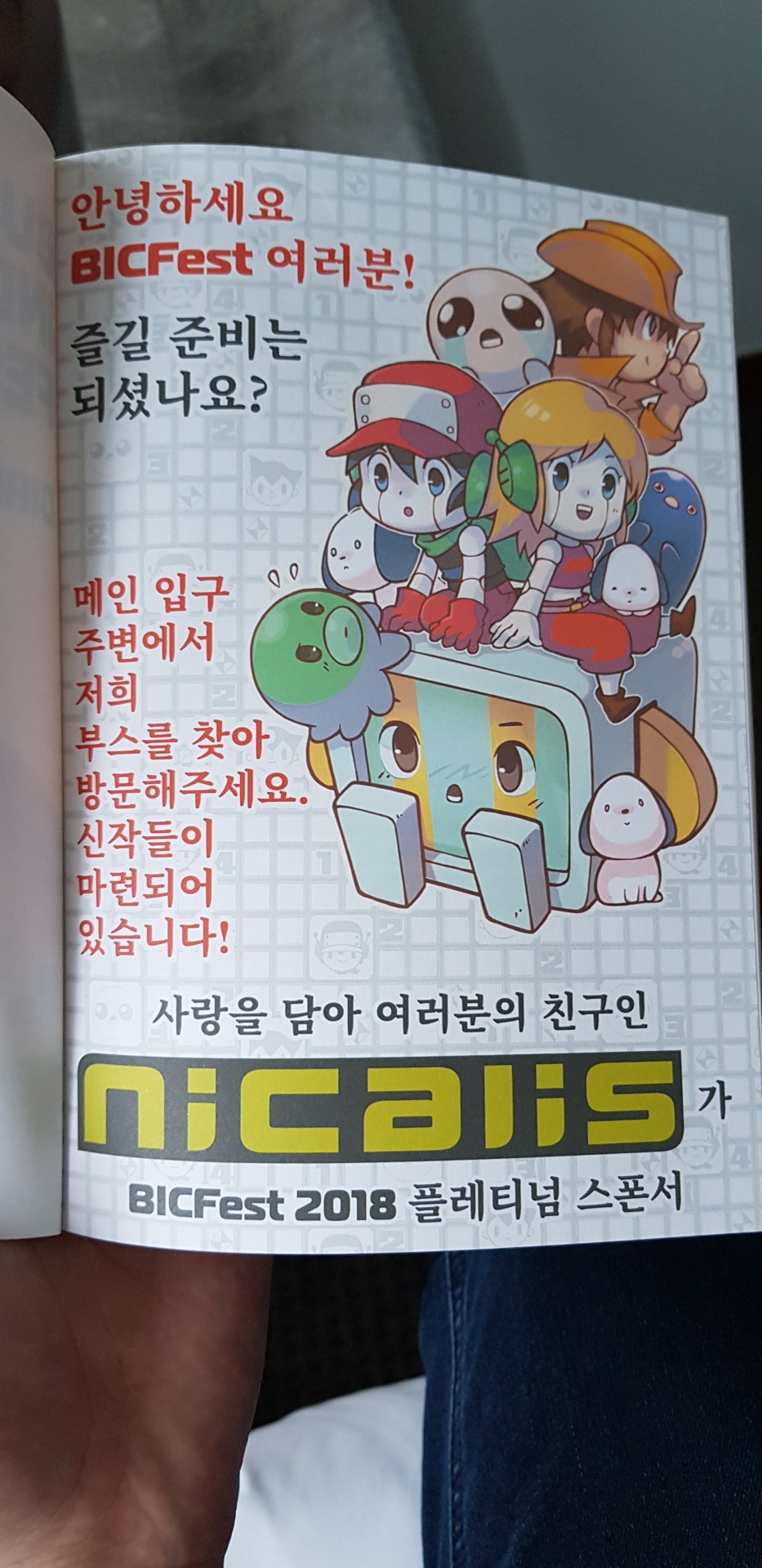
And when I came back to my accommodation, this BIC platinum sponsor, Nicalis, welcomed the exhibitors with a very impressive font(...).

It is the appearance of the Haeundae market. It feels very different.
First Schedule - Conference Day
It is the day when the exhibitors of BIC gather in the movie theater and give a lecture to people gathered in various fields all day.
It's time to share and learn important and useful information about indie games.
It is the day when BIC exhibitors come together in a movie theater and lectures gathered in various fields all day. It's time to share and learn important and useful information about indie games.
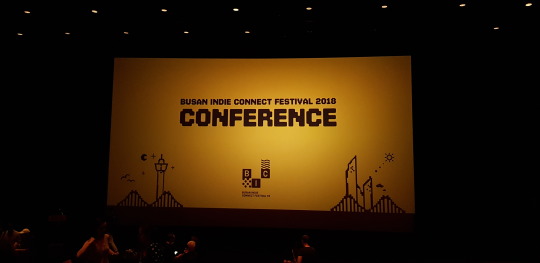
After the conference schedule, there was a network party hosted by Nicholas. Unfortunately, due to some kind of reason, I could not participate...
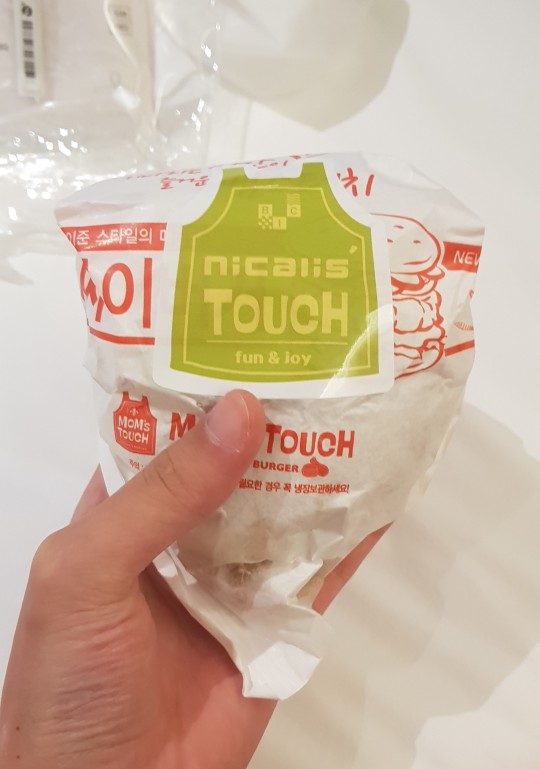
Still, Waffle went to the party and brought a Hamburger called Nicalis Touch(?).
Second Schedule - Business Day
Business Day is a time to prepare booths and communicate with the developers again before the exhibition.
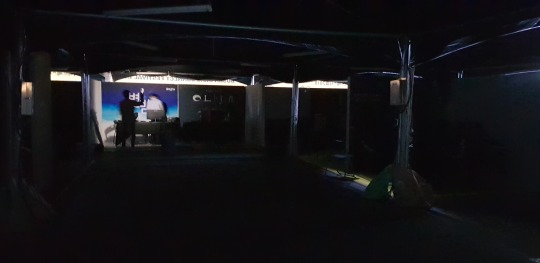
B-15, The Starry Night's booth. And we check out the equipment we requested...
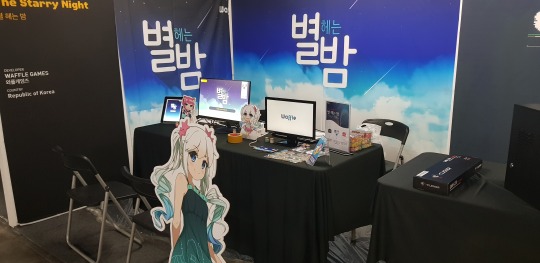
We hastened to prepare the booth. Waffle made many preparations for this exhibition.
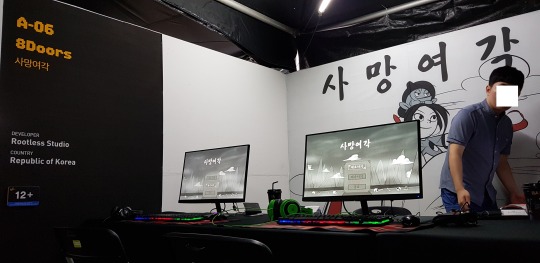
And I have seen 8 Doors that show this time again since Unite Seoul 2017. The game has changed a lot. I was surprised to see that the development was progressing to some extent and that the game was also a more well-caught frame. I will expect it!
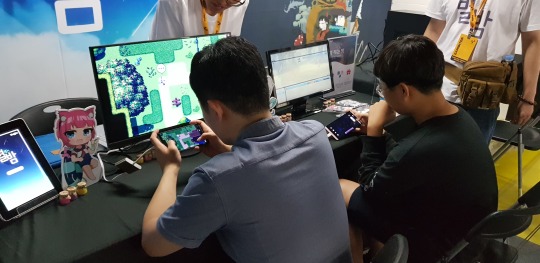
And as the developers of 8Doors have used RPG MAKER since before, so he interested and have also come to The Starry Night. he was talked a lot about Waffle and MV.
In the meantime, LSH, a representative of Psychoflux, came and talked for a moment.
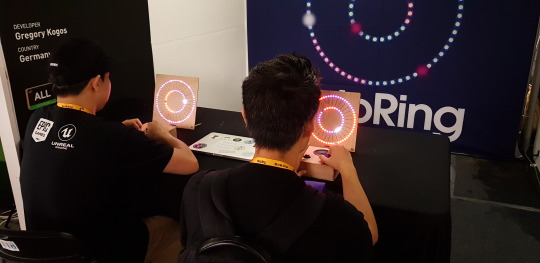
And this is an analog game that was personally the most expected.
youtube
As you can see, I expected that it was a game that had both sound effects and game play with the idea that it can not be tried anywhere because it is not software and play video alone.

When completed the game, it is shown play time of game. The number of red dots in the center is minutes, and the red dots on the outside are seconds. It took four minutes and 45 seconds. It was a really fun game.
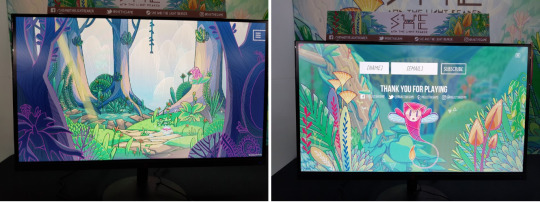
SHE and the light bearer is a conversational point and click adventure game. Overall, the art style was cute, too, and the characters had a unique voice in the conversation. To briefly summarize, it is said that a firefly leaves the adventure in search of a lost mother.
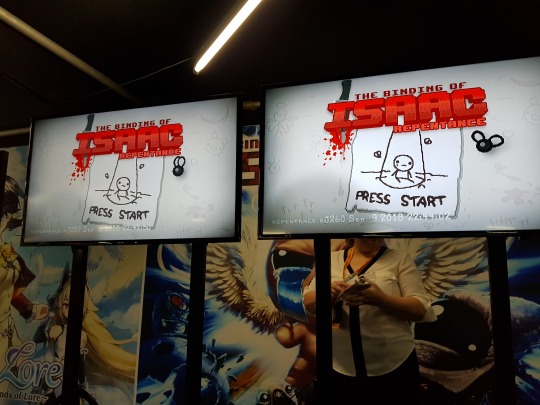
Nicalis has been able to play Crystal Crisis, RemiLore, The binding of Issac: Repentance, Dungreed's Nintendo Switch version, Blade Strangers. The binding of Issac: Repentance confrimed can do Co-Op play by ask question. The demo ends on the third floor.
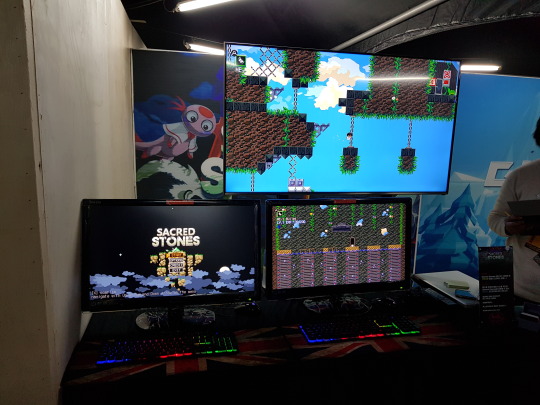
It is a very difficult boss rush game, SACRED STONES. I thought it would have been nice to have a headset or a speaker for experince but there's doesn't have, anyway I think the game itself is really cool.
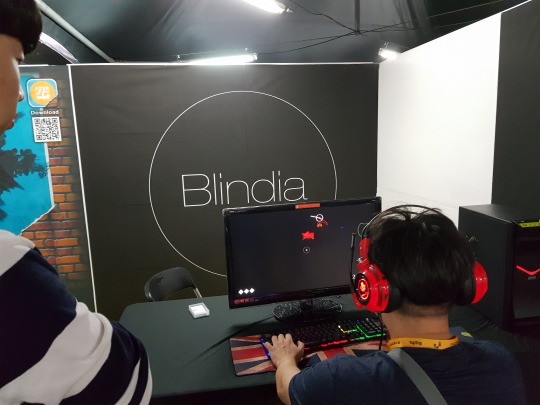
IndigoBlue Game Studio's Blindia, famous for SPLIT BULLET and Vectorium. This game has DARK ECHO's style and with the action and strategic aspects are highlighted. I can shoot a gun!
youtube
Dance of fire and ice was also seen by the developers themselves. I can see that the developer has changed from Flash to Unity and the graphics have improved significantly, but I have not been able to shoot properly with the camera. In addition to what you can see in the video, and some pretty interesting variations such as a diagonal column.
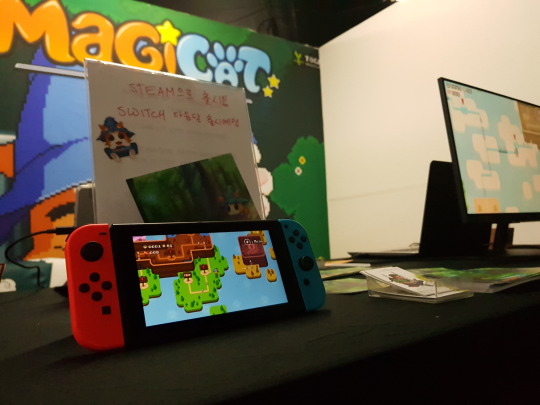
It's called MagiCat, and I played the game for a while. Oh my gosh... It's impressive that if you like cats, you might be stunned. It was also a good game design.
So the schedule is over...
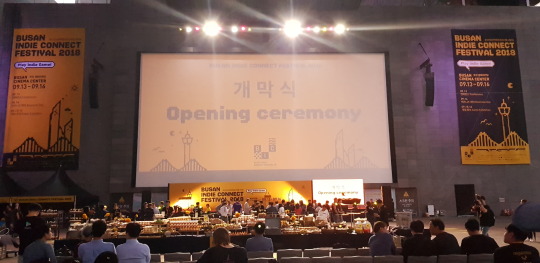
And it is the opening ceremony informing the start of the event!

A variety of food from the support of the Canadian government was displayed at the front. I ate taco with sauce at first time!
Three, Fourth Schedule - Public Visit
Now, the weekend is finally here to can communicate with players and gamers.
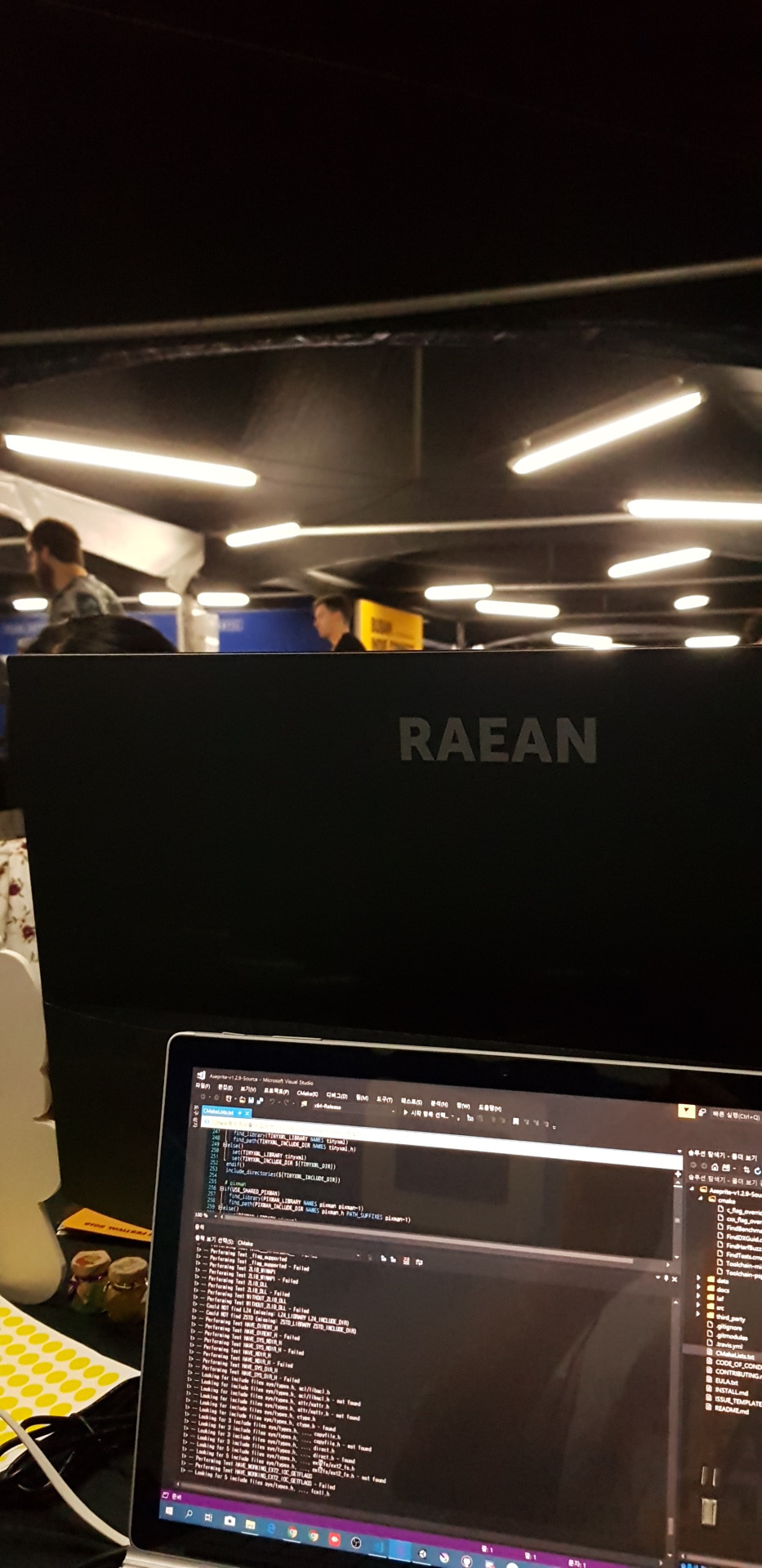
But I did not make The Starry Night directly, so I helped organize the booth and guide and introduce foreign guests. Photo shows I had Aseprite's source code build(...)

By the way...
At first, Aseprite has laggy were caught. I initially thought this was due to the fact that it works in debug mode, but the real reason was the 4K resolution(...)
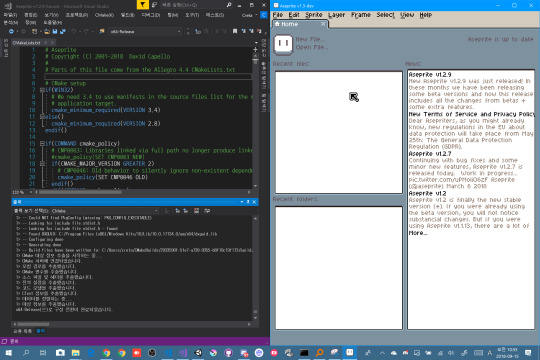
Anyway, if change the target to system in Program > Properties > Compatibility > DPI then can use it normally.
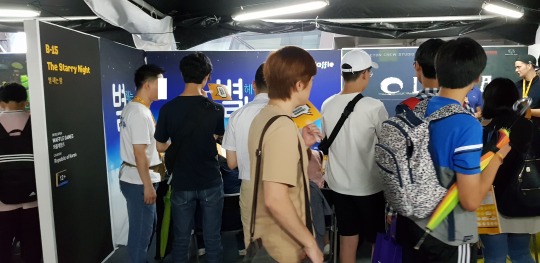
I heard from the end, but there was a story that there were many speculations that this BIC would have come more people.

Waffle surprisingly made the demo quite long. It's hard for many to enjoy, but I think this will help people know what game is.
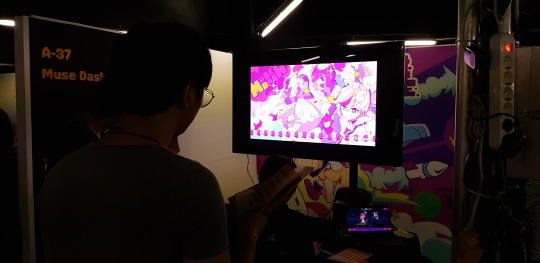
This is Muse dash. It was an impressive game because the animations were made to fit well into the beat.
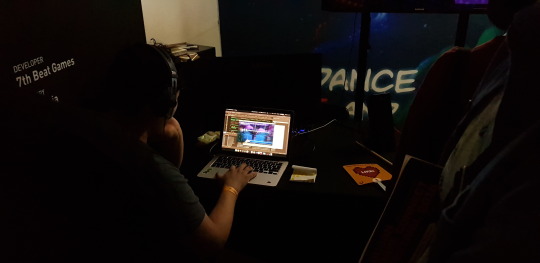
Wow, there was a place to show the development. He is a developer of the rhythm doctor, Dance of fire and ice.
During the exhibition, one developer has shared a leaflet.
"Let's have an informal party and get together at Haeundae in front of the hostel at 9PM!"
So we arrived at Haeundae and it was 9PM, but I could not see people, so I gave up and tried to return. However, I found a person wearing an ID card on the other side of the traffic light, and the developers who were wandering around looking for a party place gathered one by one and the party proceeded.
It was a good time to talk to a lot of developers here. I had talked with LSH again, and he says I have been watching the development journal steadily, and I was surprised to see you doing the animation work.
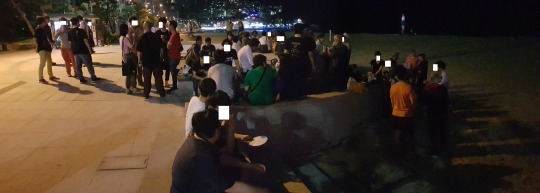
I had a schedule to perform the awards ceremony and the LAN party once again from 5:00 on the last Sunday, but unfortunately I came back as soon as 6 o'clock due to personal reason.
But this opportunity is not uncommon, so I think it makes sense.
Oh my legs!
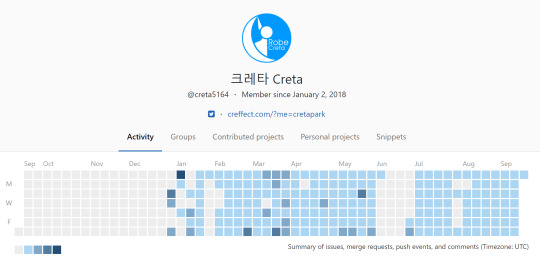
I am still making a small part of the plot and game system, and still keeping one commit per day. In the future, the amount of development journals will decrease. Because, as I mentioned at the beginning of this devlog, there are a lot of things I'm working on that are hard to disclose. I'm sad.
LSH said for that "most of the indie game developers when if keep writing the devlog, they arrive at this point, the devlog's post date term is getting longer." And he said, "that is a natural process. if you are worried about the devlog's quantity, how about put up a devlog every two week?" So I decided to try this part of the time.
One day I will improve my perfection until the day I show my game from there.
See you in next week, thank you :)
2 notes
·
View notes
Text
We talked with the hidden voice of this year’s Bulgarian entry, the unique group, EQUINOX. They brought darkness, quality, woman with a white wig and 2 Americans to Lisbon. And now it’s time to know more about the 6th sense they took to Portugal with them to make -even- more wondrous their show.
Maria Dimova is a Bulgarian singer who is interested in Bulgarian folklore music and R&B also. She competed at 4th Season of The Voice Bulgaria, and she was one of the people who chose Poli Genova– Bulgarian representative of 56th and 61st Eurovision Song Contest- as a coach. However, she continued her further The Voice destiny with other coach Ivan Lechev. But who would have known she experienced Eurovision one fine day. Borislav Milanov gave this opportunity to her, thus this incredible voice was introduced to us.
Let’s give ear to her Eurovision story;
1. Everyone was wondering about the great back vocal in Bulgarian team. It is time to clarify it! Could you introduce yourself us, please?
It’s not a secret that I was the backing vocalist of Bulgaria this year. I was introdured in the postcard of the Bulgarian team, at the press conference, too, in interviews in Bulgaria. Maybe you didn’t notice because my role was to be that mysterious voice from the space. That’s why I ‘m not on the stage, I’m not on the spotlight. I ‘m like the sixth sense of the group, something cosmic, something deep inside in every soul and that’s why there’s no need to be revealed on the stage.
I’m Maria Dimova. My stage name is MIA D. I ‘m 29 and I been singing my whole live. I know that is trivial but it’s true. I’m singing Bulgarian folklore and R&B.I ‘m part of one of the most popular choirs in my country -Cosmic voices. I have solo career as r&b singer,too. I’ve released two songs. My debut song is Bbboy and the second is called “Да Бебе” (“Yes Baby”). I was in The Voice of Bulgaria 2018.
2. What did you think/feel when Eurovision was proposed you for the first time? How did you imagine yourself on stage?
Borislav Milanov – the producer and one of the composers of the song invited me. God bless him! He gave me a huge chance to feel that experience. He told me that he is super insprired by my talent. I told him :”I’m super inspired by your talent for making music and It’s such an honor for me to be part of that powerful song”
I imagined the feeling to be heard from all over the world and it’s was incredible. I’m so proud that Bulgarian folklore one more time proved its power.
So excited to be on this stage ! We are going to the final with Bones on the 12 th of May! Thanx for supporting us 🙂 #equinox #bones #bulgarianteam #bluecarpet #lisboa #allonaboard #cosmic @equinoxbulgaria @mia.d.official
MIA.D.Official (@mia.d.official)’in paylaştığı bir gönderi (9 May, 2018, 12:53öö PDT)
3. You started – and also ended- your performance with high notes. It is really difficult but important mission. How did you rehearse for your performance before staging?
Yea, It’s true. I did my own warming-up songs(special folklore songs for warming-up), also Trey helped me with some very useful exercises.
4. Please be trust :)) Did Zhana Bergendorff sing the high note parts of song with you? I want to ask this question since lots of fans still think that Zhana pretended she sang the song at that parts.
I’m honest. The beginning was mine and I have a parts in the middle of the song but at the end we were together. We sang in unison. It was amazing feeling!
5. If Bulgarian national broadcaster offers you Eurovision again as vocal act, would you accept it?
Only God knows! Even though I wasn’t on the stage for me was like I ‘m on the stage in the best mysterious way! I’m so thankful for that experience and I couldn’t think about the future.
6. If the answer is YES, what kind of song you would prepare (pop,ethnic,ballad etc.) ?
Wooowww for sure a good song is the most important thing! Maybe something hot and sexy like me! – Haha- Some sick song. Why not with ethnic ellements(Bulgarian folklore).
This slideshow requires JavaScript.
Interview with 6th sense of the EQUINOX: Maria Dimova We talked with the hidden voice of this year's Bulgarian entry, the unique group, EQUINOX. They brought darkness, quality, woman with a white wig and 2 Americans to Lisbon.
#Eurovision#Eurovision 2018 Bulgaria#eurovision bulgaria#eurovision bulgaria 2018#Eurovision Song Contest#Eurovision song contest 2018#lisbon eurovision#Maria Dimova#MIA D.#Poli genova#Who was the back vocals of Equinox?
1 note
·
View note
Text
Dev Diaries: Midday check-in-Day 2 Getting There
Today's Plan, Start of Day
Dear Dev Diary, Masterlist
Not as chaotic this time 😊
It's 8pm (my mid-day...) and I have the bulk of the courses finished! 🥂 I've already thrown in some that I wasn't planning on... 😁 nothing crazy and all relevant...mostly hehe
Design Study
I have officially finished 4 out of the 6 fuller courses on UX that are available! Yay!!! I didn't think I would get them all done in time. I'm very near finished with the other two as well. I have done so many of the stand-alone courses on top of those. If I didn't do any more courses I would still feel more than accomplished. But we stop for nothing!!! (nothing except my subscription ending lol)
I do seem to lean more toward the design side of UX instead of research.
Oh! One thing that I'm not understanding is whether Interaction Design is considered UX or UI?
It makes sense that it's in the middle. But I thought UI was more graphic design, not so much the interactions themselves. It isn't a huge difference necessarily, but it helps to know what to look for when searching for jobs. 😂 I've seen posts and people mention that UX, UI, Interaction, and Visual are all different... "Interaction Designer" doesn't really pop up much on its own in searches though. I assume it's under either UX or UI? Or is it just rare?
These are the things that will keep me up at night.
(Note: I did look it up. It always has nice explanations in posts that are about sorting through the types. I'm asking this question more in practice.)
Dev Study
HTML is so much fun!!!!!
I got the courses finished that I needed to make sure I got done today. Phew... but, that does make me closer to the CSS video lol I might actually start it tonight. We shall see what I get done!
I noticed in the basic HTML courses that the majority of issues that I see with websites (before design study) are all HTML issues. Not only that, but they seem to be fairly easy fixes. Of course, I may learn more reasons later on about why everything else actually made it more complicated than that.
Perhaps it's because of my blogging and general site interactions over the years, but HTML seems fairly intuitive. Maybe someone who doesn't have blogging experience wouldn't feel that way though?
Either way, I'm super excited to get into CSS soon and get to play around more. And then to JavaScript!!! Onward!
I have SO MANY PLANS!!!!
The problem will, in fact, be making up my mind on which one to do (first, and only "making up my mind" once and then sticking to it 😅😋)
Maybe I'll do a poll when the time comes and let the internet decide. Who knows lol
I'm going to try and get back to it. I'm gonna start the Agile courses 👀 pray they are the correct courses I need 😅🤣
#codeblr#studyblr#learning to code#learning tech#i love learning#web development#webdesign#ux design#neurospicy#neurodivergent#count down#day 2#mid-day checkin#dev diary#diary entry#journal#tech journey#tech jobs#techcrunch#techy stuff
0 notes
Text
One Year in Denver
There comes a time when you realize that even though everything seems to be going ok, that it’s really not. Your friends have been telling you this for awhile but you were pretty sure you could pull it together and make it work out.
That doesn’t always seem to be the case.
Sometimes, despite everything, you need a clean break.
I had moved out of the house in Sunnyvale and I was staying with friends and I got this email from a good friend about a job in Denver. I applied and the boss of the new company called me the next day to fly out that Friday. I delayed it until the following week as that was Mother’s Day and it was a good excuse to take the day off and spend a few days in Denver because why not.
Those of you reading this know the rest of the story.
So it’s been a year now and some things have happened. First off, back in January, the company was sold off. I do understand why it was as the previous owner was starting to get bogged down by running a company and he didn’t really have much marketing experience. I don’t fault him for his decision and he seems happy in his new direction.
The move here has also brought about it some self reflection. Right now I am living alone and it’s not too bad. I’m still meeting some new locals. I can get around most of the area without a map. I know most of the major freeways and streets. I can get home about six different ways depending on traffic conditions. The weather has been nice and I lived though my first snowfall. I have been downtown a few times but I still have yet to do my planned day or weekend. Denver has this Berkley feeling without being so Berkley and Colorado is a very purple state. As much as I see pride flags, I also see lots of big ball trucks,
I have yet to find Denver’s song yet. Every place I have ever lived has a certain song to it. I don’t mean something you’ve heard on the radio or some popular tune. It’s more of a feeling and a mood if that makes sense. This is the first city I’ve ever lived in that I didn’t know much about the area before moving here. At least with San Francisco, I had visited so many times I already knew most of the town before moving there. Denver wasn’t like that. I had only been here for that short trip I made before the interview and that was really about it. So it’s been rather odd and interesting to me to find out what this town has.
I’ve also gotten out of my other slump. I took a number of programming classes and didn’t find many jobs at all and I felt pretty depressed about it but recently started getting into WordPress Development as it fits pretty well into what I do like, which is HTML, CSS and some PHP. I’m not very strong at Javascript and that’s fine. I’m honestly not too worried about it as this point. I can still do some basic things with it and JQuery so I figured maybe with some more experience and time it will start to make more sense.
Part of this decision was that I’m just so tired of this industry. I did try to get out of it when I was in the Bay Area, but I think I had too many things going on that it was hard to get things done. The house I was living in was not very good for my state of well being and now that I’m on my own, my head is a bit more clear. I’ve been doing a lot of self reflection and thinking and it’s been quite good.
Been also noticing that in the past few months that my depression has cleared up a lot. I started seeing on again once the winter months where hitting. I know I have a light case of seasonal depression and I saw a doctor a few times, but recently I have been feeling a lot better. I think part of that it that I’m a bit more financially stable and I have been sticking to my exercise routine. I also do about four to six miles of walking on the weekends now.
2 notes
·
View notes